Early in the 1940s, racing “a murky sky between showers, five cars of Omahans, four to a car, went treasure hunting,” under the direction of Mr. and Mrs. Joseph Stocker. The Stocker couple, no doubt, enjoyed hosting themed parties, as was the trend of the day– this particular one, carried a noir bent. “The hunters, equipped with flashlights, old clothes and clue No. 1 drove out West Pacific Street.” The hints, worked out with detective story intrigue by hostess Mrs. Stocker, led the curious carloads zigzagging all around town. Lost, several clueless groups would call the Stockers at home, only to be “fined five minutes for each call.” Distant points off the beaten path, such as Papillion and Millard, were mocked by the hawkshaw party-givers. But it was a mystery clue that steered the few hunters to “a niche in the wall of the West Pacific summer home of Dr. and Mrs. C. C. Tomlinson” that drew me into the game.
Decades later urban legend would shepherd other curiosity seekers to the Tomlinson’s property. However this time it was teenagers who would travel across town on late night pilgrimages in hopes of discovering “The Albino Farm*”, rumored to be located deep in the woods near 114th and Pacific. Empty-handed experiments fueled by folklore and incredulity most assuredly inspired each tantalizing or failed trespassing venture. West Omaha’s “Albino Farm” stories were infamous and seemingly inflated by early social media—word of mouth.
*The word Albino is a derogatory name for people living with Albinism, a very real genetically inherited condition. I will elaborate more on this disease, its history, social discrimination and isolationism later in the article. For the purposes of this investigation, I will refer to the local lore of “The Albino Farm” in quotes. If anyone can think of a better way to handle this phrasing, please contact me.*
Like C. S. Lewis’s giant wardrobe entrance to the forests of Narnia, the luxuriant condition of the wooded, meandering Tomlinson land would draw an enterprising developer to the brick columned entry gate many years later. Surely once within the mythical, lush, shaded wood, this gentleman began dreaming of a lavish and secure enclave for the Omaha Famous. And it was for sale, after all. Soon a posh, enclosed subdivision sprang up amid a local controversy over the man-made forest in which it grew.

Detectives, we’ve got another Space Beneath the Stairs to explore. Another Hidden Avenue. Another Secret Garden. Another Rabbit Hole. Tomlinson Woods. Let’s investigate and spill the tea. But first let me make room in this teacup-size detective office of mine. Some of your might want to kick off your shoes for this one as we might try forest bathing after our tea. Are you as excited as I am?
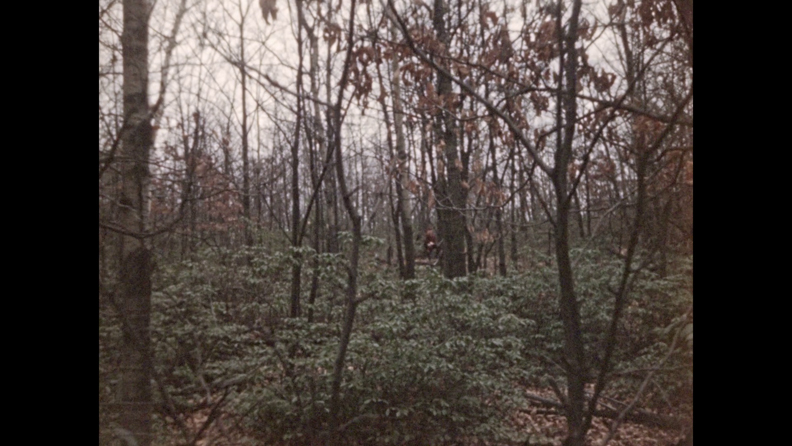
1940s film footage.
The following story is true. The people, places and events in this article are all real. The names of certain persons have been changed to protect their privacy and mine. You understand, don’t you?
Friends, Our Beginning
I began my quest for Tomlinson Woods with a very simple presupposition that its origins must have some vague connection with a Mr. Tomlinson. Now I’m no Philip Marlowe but I figured this was a worthy hypothesis. Tomlinson Woods, frankly, was very far away from my Benson-Home-Base as a kid growing up. This neck of the woods was not even on my radar until the early 1980s.

The bricked walls of Tomlinson Woods. Photo borrowed from the Kenneth Hahn Architects KHA site. From the website: “This project began as a neighborhood association project, which was designed to add a sense of security and image. The masonry retaining wall was designed for the City of Omaha Public Works Department as a public improvement. The retaining wall saved a number of mature evergreen trees adjacent to the city right-of-way, and blended aesthetically with the rest of the perimeter wall.”
Much as it was in my junior high days, Tomlinson Woods remains a private, gated community. Albeit a different gate than I recall. The homes are large and many custom built—a mix of Eclectic, New Traditional, Millennium Mansions. The color scheme is one of neutrality, the focus on the calming woods, posh homes and shaded environ. Tree uplighting and landscaping are at a premium. The Colonial streetlamps are charming. News Flash: No purple sheds allowed in the strict covenant. A drive or walk through this silent neighborhood will find the impressive homes typically built out to the envelope–meaning the Tomlinson Woods structures are found very close to the road as well as built very close together. It brings to mind the Spring Green Subdivision in District 66. If one would happen to wonder why the homes are perceivably wedged together tighter than two coats of paint, a local realtor with the Elliott Group assured me the back woodland gardens, pools and private areas are divine and where this prestigious neighborhood really excels. The homes are also glorious and spacious and once inside, there is no sense of the outer, snuggly, shall we call it, community. Homes in Tomlinson Woods are typically priced at about $400,000 and up. Yes, it is true, many of the homes have silly, high-pitched, multi-rooflines, strange medleys of design all in one building and sometimes no windows barring the front and back of the house but overall, I can appreciate their architectural efforts. A number of the residences are astoundingly beautiful but the woods are really why we are here today. Have you wandered through to find the dappled sun shining through the trees on a spring morning? I’ve marveled at the squirrels merrily scurrying about it. In the summer months, the dark shaded hush of it all. Would the lucky inhabitants even need to use air conditioning? Imagine what the fall moonlight must look like through these darkened fingerlettes reaching above in the sky. And the transformation to the winter fairy-tale setting…a frozen wooded palace with only the muted sound of birds from a pine. Or maybe a later night owl. An oasis in the city.
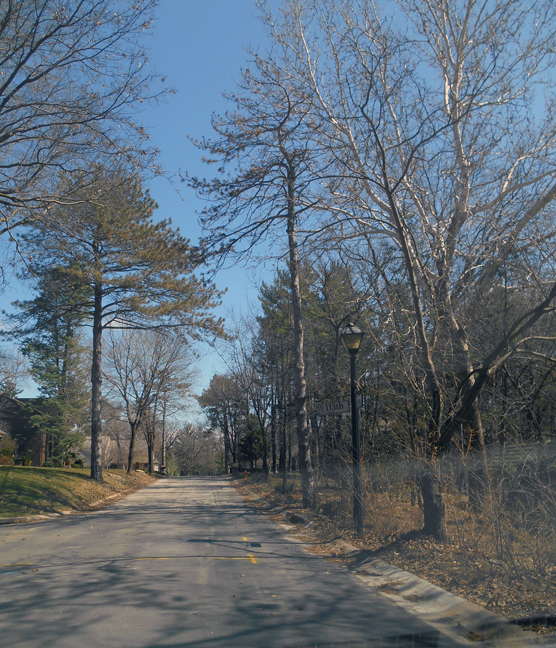



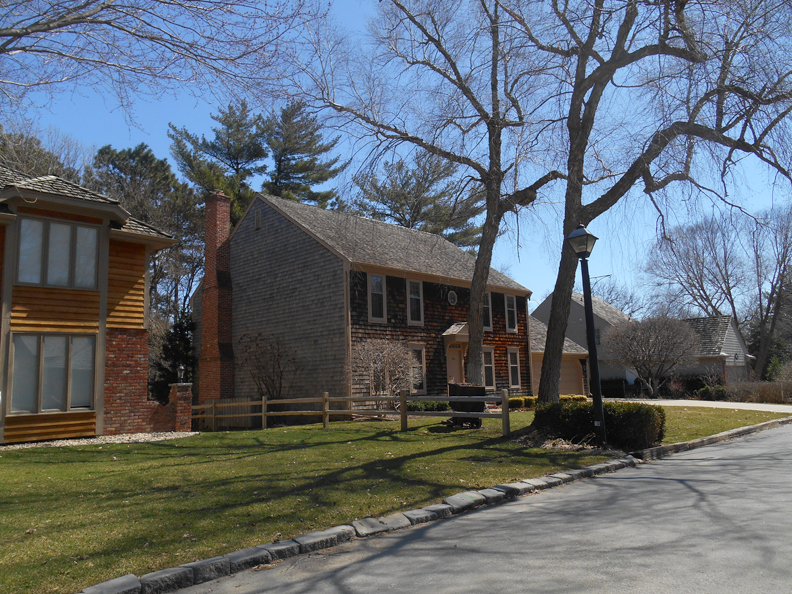
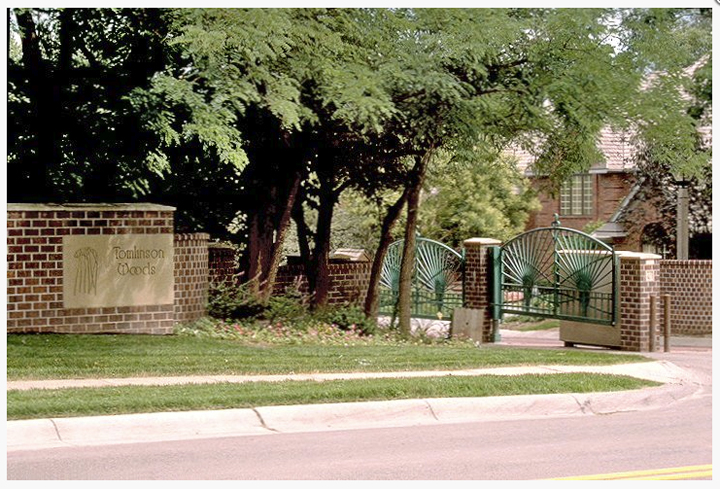
Secluded Tomlinson Woods has been home to local politicians, elite attorneys, brokers and business leaders, tycoons, moguls—you name it, since its origins. In its current state, it maintains 33 wooded acres, enclosed by a brick wall, bordered by Pacific Street, interstate 680, supposedly a southern creek separating it from neighboring homes and the Presbyterian Church of the Cross, with 114th Street serving as perimeter to the west. Now I say *supposedly* because I have not traipsed around these woods on the southern portion looking for a creek bed on the assumption that not everyone enjoys a mystery woman digging about in their private back gardens and thickets. And if I was to get arrested for trespassing, I had always imagined, it would involve Jacobean leaded glass or in this case, a missing, mystery fireplace and chimney. More on that to follow! The point being, I was not going down for a lowly creek on a perimeter when I had bigger fish I was after.
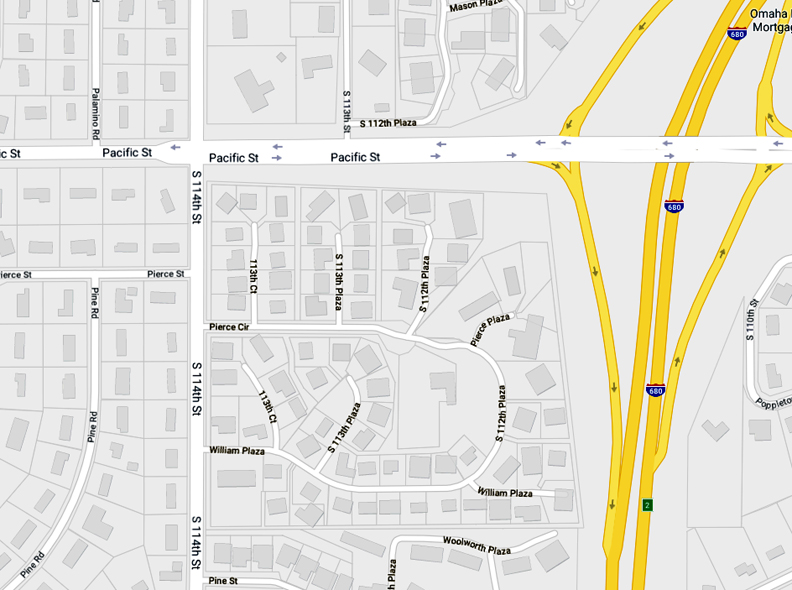
2019 map of Tomlinson Woods and surrounding area borrowed from Google Maps. Pacific, I-680, creek and 114th Street.

2018 survey of the entirety of Tomlinson Woods subdivision parcels. Numbers denote the house addresses. Map borrowed from the Douglas County Assessors site. You know how I get about my maps.
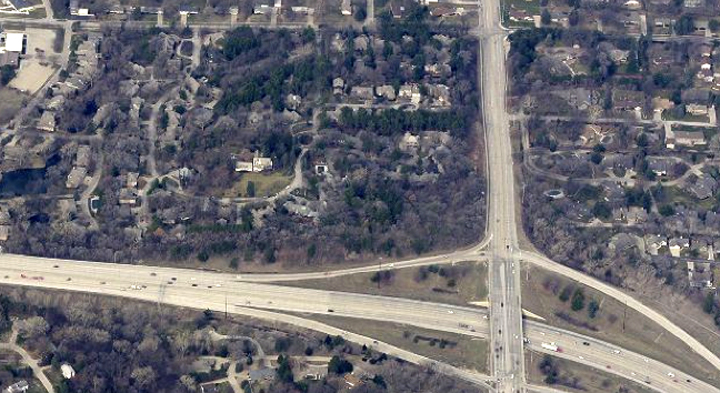
2013 aerial borrowed from the DOGIS site. Photographer is facing west. I 680 in the foreground, running north and south. Pacific cuts through perpendicularly along the north side Tomlinson Woods. And if I do say, it looks as though there is a creek or greenish blue body of water along the southern most side of the large lot.
The whole search was oddly familiar. Similar to the quest for the source of the ringing bell, in Hans Christian Anderson’s book, aptly named, “The Bell,” the lure of the forest and the discoveries therein became somewhat epic. The traveling and investigation into the invisible bell, I would find, began long before Tomlinson even founded his namesake woods. We will get more into that later but just a nibble for now: Tomlinson did not acquire the land at 114th and Pacific until the early 1930s. My discovery of an early McArdle plat map of 1920 would initiate a new search for clues.
In Search of C. H. Kuehl
The following 1920 McArdle plat map vaguely displayed parcel ownership from the period. If you are easily confused, as I often am, let me give some pointers, as this is just a detail of a much more descript map. The striped, horizontal line in the middle of the map represents Pacific Street. The vertical, double line denoted by two 20s is 114th Street. There is no I-680 (yet) so the farmland runs freely along the north and south of Pacific Street. Let me draw your attention to the “40” written at the southeast corner of 114th and Pacific. This denotes 40 acres. This is what we now know as Tomlinson Woods. There is a diagonal line connecting it to what would be the northwest corner of 114th and Pacific—site of the 120 acre C. H. Kuehl Farm.
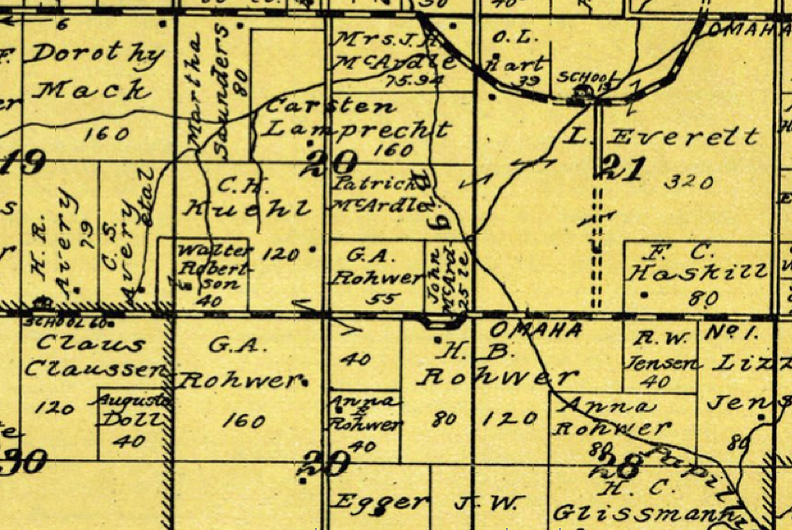
Portion of the McArdle, Millard, Douglas and Benson Townships, Nebraska. Published by Anderson Publishing Co. in 1920.
Mr. Henry Kuehl was a long time resident and farmer of Douglas County. He was married to Margaretha. The couple had two daughters, Lena known as Mrs. Hans Bock of Benson and Tena, known as Mrs. Henry C. Glissman of Omaha. By the way this is our same Glissman family from the I Want to Live in the Swanson Towers investigation. The Kuehls also had three sons, Christ, Carsten and John.
Christ or “Chris” Henry Kuehl lived his days farming on the two opposing corners of 114th and Pacific Streets. This is our “C. H. Kuehl” as seen on the map. To put a finer point on it, the land we now know as Tomlinson Woods was farmland–a cornfield. The many trees would be planted later in a decades long passion project. Chris Kuehl was born in 1876. He filed for a marriage license in 1902 with Emma C. Schomer (born in 1878) of Douglas County. Unless I’m totally turned around, I believe Farmer Chris might have been married previously, as I found “Christ Kuehl and wife sold to Henry Kuehl lot 8 of Lubbe’s subdivisions” in 1897. That would mean a married, 21 year old Chris was selling land to his father. Was this an uncle or other relative carrying the same name? I could not be sure with which wife Chris Kuehl had six children: five sons, Clarence, Henry, Arthur, Roy and Chris, Jr. and a daughter, Vinna (sometimes sp Verna).
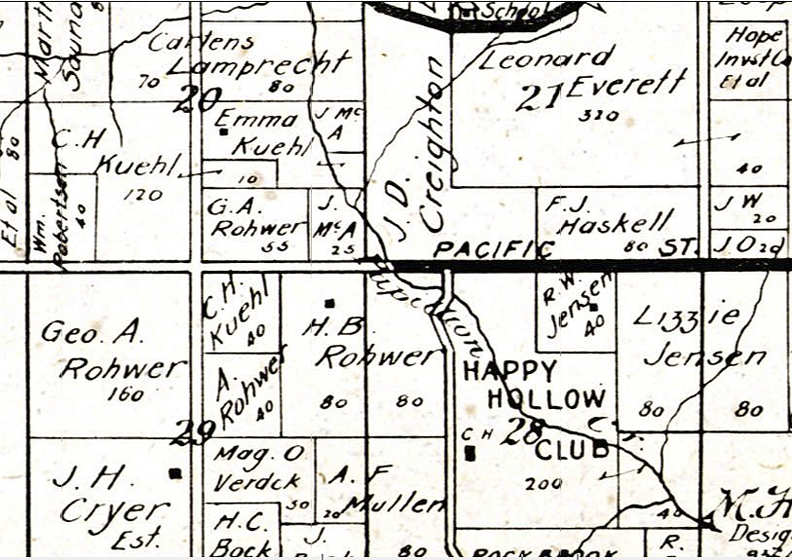
Portion of the McArdle, Millard, Douglas and Benson Townships, Nebraska. Published by Anderson Publishing Co. in 1925. The 1925 map is much the same with the addition of the Happy Hollow Country Club on what was the Glissman Family farm. Also note A. F. Mullen’s property. Mullen was one of the many stars from our The Curious Case of the French Fairytale Cottage: Part One.
Before his marriage to Emma, “C. Kuehl was overseer of highways in the McArdle precinct” in 1901. A lifelong passion, from what I would find, Kuehl was an early advocate for the upbuild of West O, then coined McArdle Precint or Township, after the George McArdle family farm. In 1916 Chris Kuehl, along with Ben Schomer, George Rohwer, William Jenson, H. C. Glissman, Henry Rohwer and George McArdle were elected officers of the “Douglas County Good Roads and Improvement Club”. The good roads boosters aimed to raise million dollar bonds for the improvement of the Douglas County roads. If you assess the 1920 map, these fellow advocates were also neighboring farmers–Schomer and Glissmann were also relatives.
Kuehl’s son would later tell the press that his father “farmed the land that is now Boys Town.” A survey of the map would suggest the Chris Kuehl family home was situated on the northwest corner of 114th and Pacific, in what is now known as the Meadow Lane Addition, caddy corner to Tomlinson Woods. After a brief excavation, it appears the Meadow Lane neighborhood, from 114th to 120th along Pacific, initiated their marketing campaign in 1956. I would discover that Chris H Kuehl died in June of 1955 at the age of 78. One might assume that Emma sold that land after his death, but I could see that the couple had sold to the Meadow Lane developers before his death. Chris Kuehl is buried in Omaha’s Pleasant Hill Cemetery. Emma Schomer Kuehl died in 1968.
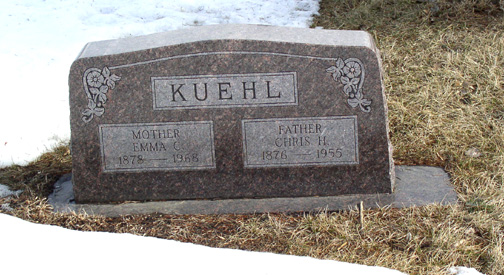
Chris and Emma Kuehl’s headstone. Photograph from the Find a Grave website. Image by Ren.
The H. B. Rohwer Connection…and All of the Other Rohwers
The bell from the woods became so strong and so persistent that I will admit I got all topsy-turvy spun about. At one time I thought for sure Tomlinson Woods had been situated on the neighboring farm’s plot– the H. B. Rohwer land. It is true I went Hog-Wild and did a full mistaken investigation believing he was the original owner. A part of me wants to divulge these clues right now but I will call a Halt! to my little indulgence and limit myself to two essential Rohwer paragraphs. Because, you see, the Rohwer clan does play into this mystery.
Henry B. Rohwer and wife, Emma M. Blum were married in March of 1903. They would have three children: Ferdinand C. Rohwer, Myrtle F. Doll and Herbert Henry Rohwer. The family lived on their McArdle Township farm adjacent to what we now know as Tomlinson Woods. From the 1880 United States Census I would learn of H. B.’s father and mother, Henry and Anna Rohwer, whom had emigrated from Holstein, Germany, giving birth to our Henry, in 1878. I found evidence in 1928 of a George A. Rohwer, farmer, residing “west of the Happy Hollow Country Club”. George Rowher’s plots are also seen on our 20’s maps and I believe he was a brother to Henry. A bigwig in the area, George would continue to make news into the early 1940s– his Holstein cows, sometimes fetching over $400 at market. He was also rumored to have owned the land that would later become Boys Town. I wager that the Anna E. Rohwer plat to the south of Tomlinson Woods was Henry’s mother. Truthbetold, it seemed as though there were a whole slew of Henry Rohwers in town, all of German descent but Miss Cassette won’t burden you with each slippery slope. Although it was fascinating and sometime I will probably be Compelled to write up a huge story on the numerous Henry Rohwers of Omaha.
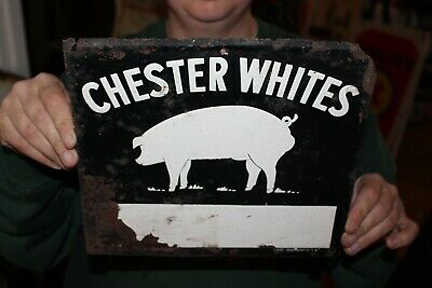
1967 Chester Whites embossed tin sign.
But allow me to show you how and why the neighbor, Farmer Henry Rohwer, became a Person Of Interest in my book. I would find the “Chester White Swine Record, Volume 25, Part 1” compiled by Chester White Swine Record Association of 1919. This document displayed Mr. H. B. Rohwer bought and received a whole lotta pigs from a Mr. R. A. Parmenter of Kenesaw, Nebraska. Now you are not going to believe this but…“Usually, the body of the Chester White Pig are totally white, and the ears of the breed are medium in size and droopy.” This white breed of pig originated in Chester County, Pennsylvania; some argue they have mating origins to the white boars of England referred to as a Bedfordshire or Cumberland. To the Wandering Wayne, these Chester White Pigs were possibly mistaken as a herd of albino pigs. Is it plausible that “The Albino Farm” legend grew from the Rohwer Chester White sounder of swine? The pale team abutted the Kuehl farm, possibly wandering their land as well. Years later, the Tomlinsons would also share a fence with the Rohwer clan. File this away, detectives.
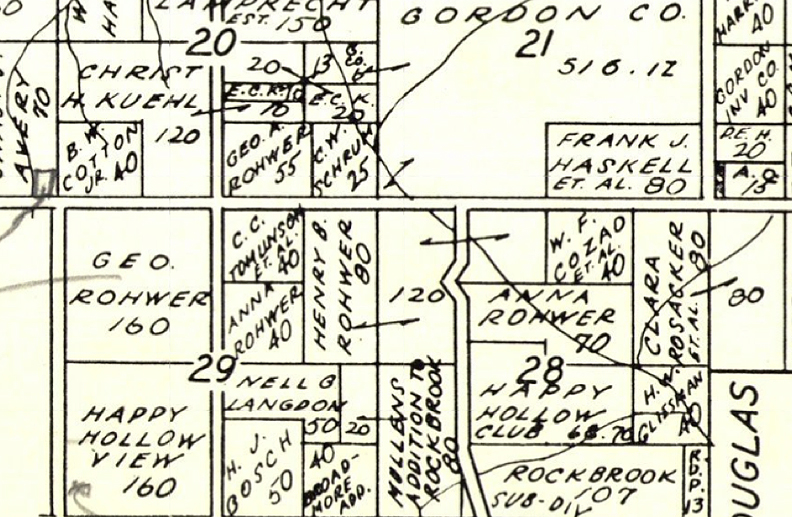
Portion of the McArdle, Millard, Douglas and Benson Townships, Nebraska. Published by Anderson Publishing Co. in 1938. This map reveals Kuehl had sold the 114th and Pacific property to C. C. Tomlinson by 1938. Christ H. Kuehl remains caddy corner; the Henry Rohwers are directly to the east with 200 acres; Anna Rohwer maintained 40 acres to the south; George Rohwer to the west of 114th with 160 acres and to the north with an additional 55 acres. From what I could put together, C. C. Tomlinson purchased the 40 acre farmland at 114th and Pacific back in 1931. I couldn’t help but wonder why the Rohwers didn’t snatch it up from Chris Kuehl? Perhaps they wanted it or had made an offer? From what I put together in my book’s research, the lean years of the Great Depression were when many wealthy Omahans acquired land out west. The price was right. Let us draw in on the Tomlinsons.
The Lead On Dr. Tomlinson
Dr. Charles Creighton Tomlinson was born in 1884 to parents Creighton Charles Tomlinson (an efficient name exchange) and Sophronia Willeta Martin Tomlinson in Villisca, Iowa. The four Tomlinson siblings, Fred, Charles, Stanley and Ray grew up in this beautiful, pastoral setting on the family farm, attending the Red Oak schools. The C. C. Tomlinson farm was said to be two miles east of Red Oak and apparently a sightly spot indeed, as it was later purchased in 1919 as future site for the Red Oak Country Club. Charles Tomlinson was a 1908 graduate of the University of Nebraska College of Medicine. Subsequent to graduation and an internship at Douglas County Hospital, he practiced in Wakefield, Nebraska. According to Omaha’s Who’s Who society book, Charles married Miss Nellie Winn of Omaha in 1909. The young couple would have two daughters– Margaret Maye Tomlinson and Elizabeth “Bunny” Creighton Tomlinson.
Although Dr. Tomlinson is possibly remembered in ecological circles for his lifelong tree planting obsession, he was at one time, most revered in Omaha for his medical speciality. After his practice in Wakefield, Tomlinson would make a life changing decision and follow an intensive track focused in dermatology; he would complete graduate work at the Vanderbilt Clinic in New York City. By 1917 he joined the faculty of the College of Medicine, now UNMC, as an instructor in dermatology. After several promotions, he would found the Dermatological Clinic, where he began teaching young doctors and nurses for over thirty years. Of note every year he and Mrs. Tomlinson would take a medical student to live with them in their home. I was pleased to see UNMC continues to offer a scholarship in Dr. Tomlinson’s name.
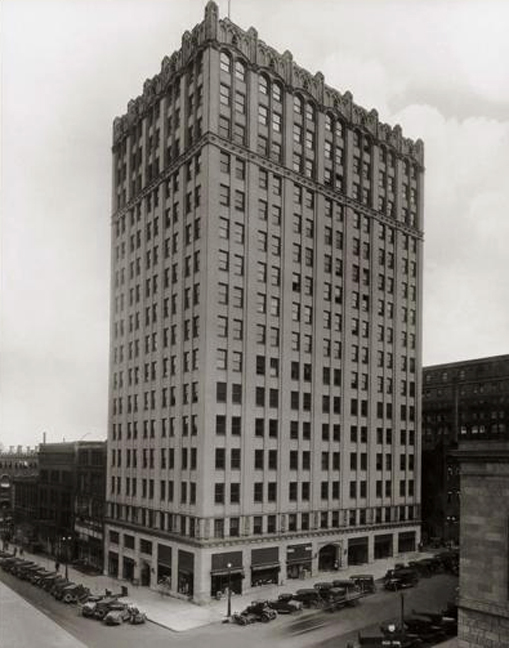
He also enjoyed a long partnership with Dr. Olin James Cameron at their office in the 1520 Medical Arts Building. The popular Medical Arts Building, built in 1926, was located at 101 South 17th Street. The structure was torn down for the 40-story First National Bank Tower; its new glassed entryway sadly offers up a portion of the Medical Arts façade. To my suspicious eyes, always viewed as a cruel mocking trend in current architecture.
Syphilology
Tomlinson’s medical specialty of dermatology was, by no accounts, a new field and yet by the time he entered practice, skin health and ailments were gaining newfound attention. Through another study of Omaha’s unfortunate confrontation with syphilis and gonorrhea during wartime, I would come across Dr. Tomlinson’s name last year. The United States entered World War I in 1917. After the arrival of thousands of American service members to France, the second most common reason for disability, absence from duty and discharge of more than 10,000 men during World War I soon became syphilis and gonorrhea. While American camp guards were tasked with giving uncomfortable sexual health screenings for “possible sexual encounters with French women,” (leading to an aggressive irrigation by way of a solution of potassium permanganate for the awkward suspects), the servicemen eventually returned home. The United States was ignited by a sexually transmitted disease epidemic.
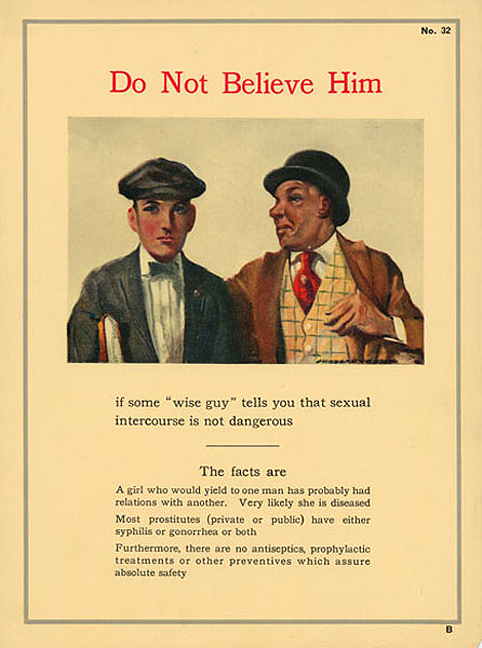

It was hard to find a selection of STD warning posters from WWI, as WWII posters appear to be more readily available. I believe the one on the right might be Canadian.
An article of 1918 revealed Tomlinson was appointed assistant health commissioner of Omaha– also labeled Police Surgeon. By that time it would appear he was a specialist in social disease cases. I would also discover he was a charter member of the Academy of Dermatology and Syphilology. During World War I Dr. Tomlinson also served as a member of the Air Service Medical Advisory board, recruiting service. In keeping with the times, the warning posters from the period, to include treatment of European sex workers as well as American sex workers, was degrading. As was custom of the day, I found some nondescript articles dealing with what I think was a subtle mention of prostitution and the rise of sexually transmitted disease after World War I. In the winter of 1919 the Omaha police commissioner issued an order forbidding the “practice of sending women to the city detention hospital without a proper court hearing.” The change was the result of public criticism of the methods employed at the hospital where women were being sent for vague “treatment,” after examination by the police station physician. “Dr. C. C. Tomlinson, who has been in charge of examining the women at the police station, has been relieved of his duties there and in the future will treat patients only after they have been properly committed to the hospital.” Oddly Tomlinson refused to affirm or deny the statement in the press. Apparently Dr. Palmer Findley, medical director of the detention hospital, would be assigned to exam the women at the police station from that point on. Equally as strange, Dr. Findley claimed to have not heard of his new appointment.
Throughout his career, Dr. Tomlinson gave local and national dermatological talks on such topics as ringworm, syphilis, eczema, abnormal skin conditions, and diseases of the nose. It was all very…visceral.
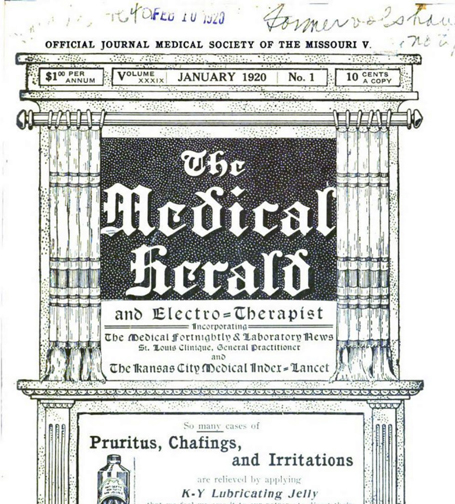

Medical Herald Volume 39 in 1920 displayed Dr. C. C. Tomlinson giving his rousing talk on syphilis.
The Domestic Life
By 1919 the Tomlinsons were well on their way into the privileged and rarefied world of the Omaha Inner Circle. There were certain boundaries and guidelines to be established after having married well and meeting the correct people. While Dr. Tomlinson was practicing medicine, Mrs. Tomlinson co-hosted bridge fundraisers, afternoon teas and other large parties recognized, at times weekly, in the Society Pages–the kind where all of the dignified surnames are displayed in a long list. Membership in the Happy Hollow Country Club would be established by 1921 and duly recorded in the Social Register. A position on an Ak-Sar-Ben committee was secured. From my position, this tiny, insular world was easily navigated by the gregarious Nellie Winn Tomlinson. Brownell Hall (now Brownell-Talbot) would be selected for the girls’ school, ponies were rode, the girls would learn to pour tea and serve only the best little sandwiches. Did I mention the live-in domestics? But before all of that the Tomlinson Home was selected.
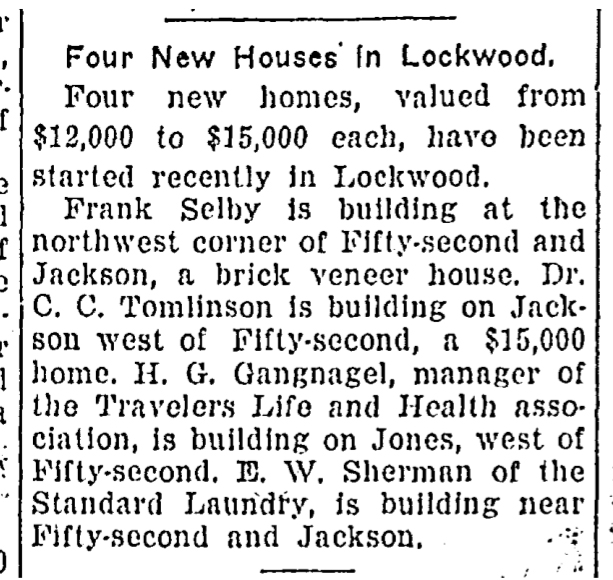
OWH July 1919 the Tomlinsons were building a new home in the Lockwood Subdivision of Dundee.
The family would build a great home in the Lockwood Addition on the southern side of Dundee. 5215 Jackson Street. The 2,292 square foot stucco home, stands at two and half stories on a gracious lot. It featured prominent, glorious trees—not a shock when we consider it was built by Dr. Tomlinson. This slightly elevated lot must have suited the Tomlinsons; I was interested to find the family would live here their whole time in Omaha. I have always LOVED this house. It is just up the street from my high school girlfriend’s family home. I can still remember wandering this Jackson Street late at night—maybe even lying in this driveway giggling at the black sky. It is such a lovely home. You must go by it and have a look.
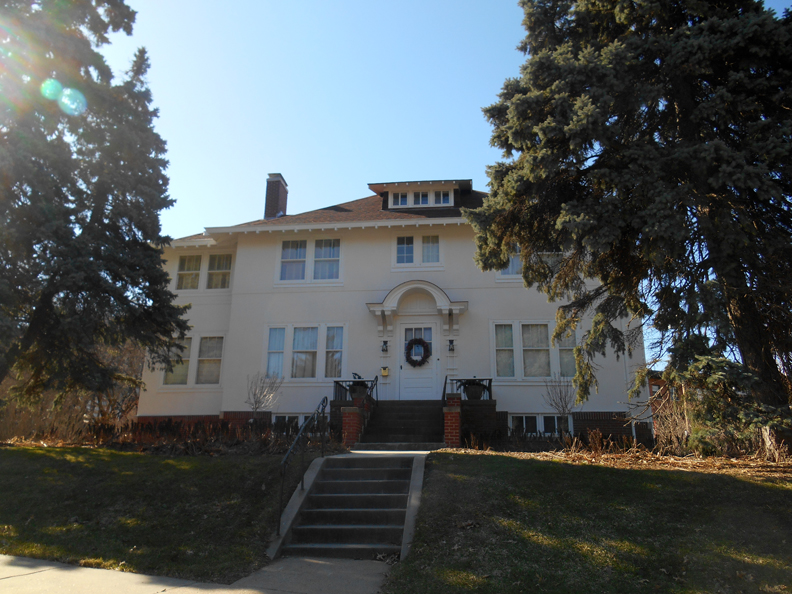


Mrs. Tomlinson’s parents, Mr. and Mrs. S. D. Winn lived at 5108 Leavenworth Street, a great American Four Square just a hop and skip from the Tomlinson’s new home at 5215 Jackson.

OWH 1926. The Tomlinson property at 5215 Jackson Street originally featured what must have been a large barn in the rear. By 1926 little Elizabeth’s Shetland pony was stolen from out back. The suspect was a Strange Boy.
The Beautiful Tomlinson Gals
Now before we embark on our delicious forest bathing excursion, I want to share a few photos of the Tomlinsons. I think it helps to give a fuller field of vision and it’s just plain interesting to imagine them stomping about in the woods. For some strange reason, I could not obtain a photograph of the good (tree) doctor. If you have a photo of Dr. Tomlinson in your possession, I would love to include it in this investigation.

OWH 1932. Mrs. C. C. Tomlinson, pictured here, is President of the Women’s Auxiliary to the Omaha-Douglas County Medical Society. What a handsome woman. I just love to say that. Considering the Depression years, she conveys a subdued beauty and poise.
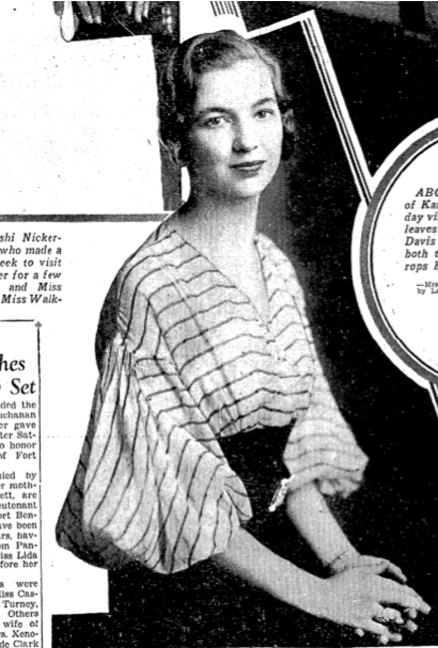
OWH 1933. “Miss Margaret Tomlinson marries.” Absolutely gorgeous and I adore the fetching sleeves of this dress. Previous to her engagement, the eldest Tomlinson daughter, Miss Margaret would attend to her studies at the Ward Belmont School in Nashville, Tennesee. Was it there that she met William Davis? The two would marry and he later became Major Davis, Army infantry officer in the 1940s.
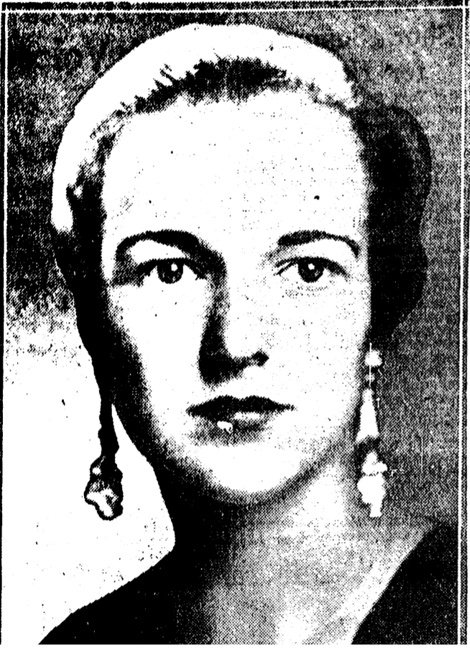
OWH September of 1934. Miss “Bunny” Elizabeth Tomlinson, the youngest, leaving for Northwestern University where she would start her freshman year. She appears somewhat Bohemian, no? Like she could have kept up with the Velvet Underground and Andy Warhol? I dream. She had just graduated from Brownell Hall in June of 1934. During her high school years, her frequent picnics hosted out at “the Tomlinson country home” had fueled many a society story. The next year Bunny became an Ak-Sar-Ben Princess, further establishing her position and keeping the circle intact. I call her the Mystery Sister because she is not easily found in any genealogy sites, although she was quite the quick-witted charmer of the local press and socialite.
Birth of the Wood
When I try to fathom the characteristics of Dr. Tomlinson, I looked to his memberships in numerous medical societies, the Tangier Shrine, the Presbyterian Church, his devotion to his wife and daughters and the fact that he was a lifelong, voting Republican. Although a country club member, his hobbies, unusual for a prominent city doctor, were that of “Trees and Farming.” That is all. From what I began to unearth about these hobbies, I believe that if given the chance, he might have ordered the above interest list in another sequence. Perhaps, once a farm boy always a farm boy.
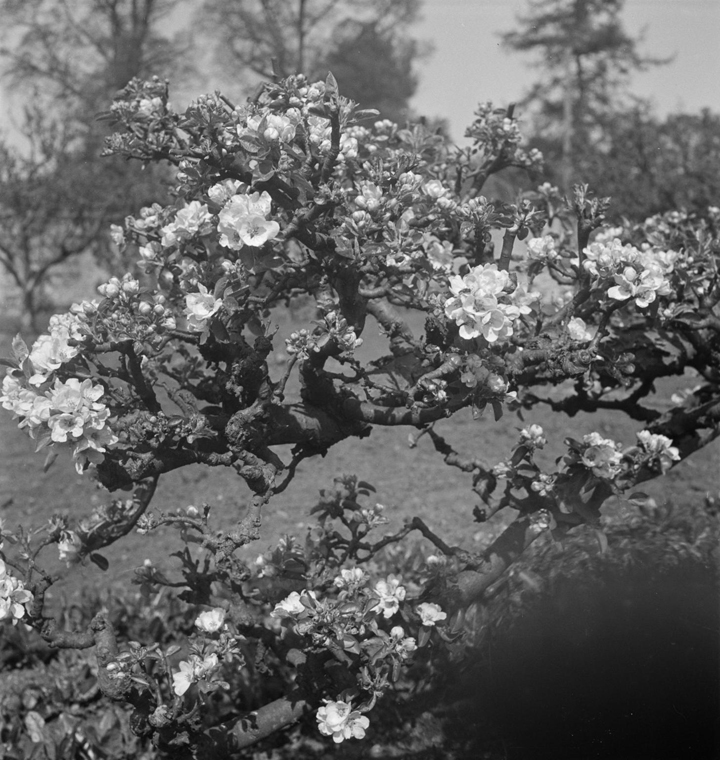
Photograph of a tree in bloom 1930s-1940s. Eileen Agar 1899-1991.
From what I could pinpoint, it was 1931 that Dr. Tomlinson acquired and “began planting thousands of trees in a cornfield, next to large native trees.” The cornfield, as we have discovered, was originally that of the Kuehl family. Charles and Nellie began their project on the 40-acre site just outside of Omaha during the Great Depression. This land was never intended to be their proper home–Quite an unflappable communication, considering what many in society would endure during those Hard Times. Rather their West Omaha cornfield oasis was truly an escape from the city and once purchased, their tree-planting dream began. I would discover by at least 1932 they had built a summer cabin on the property.
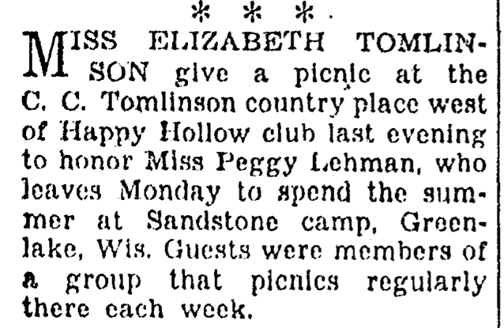
It is exciting to think about what the area looked like in those days. A great article called “Excursions, House Parties and Picnics Order of Day” from 1935 outlined the new trend of Omaha Picnics. Mr. and Mrs. George Brandeis enjoyed having steak roast in their large, private garden while Dr. and Mrs. C. C. Tomlinson, “who have a summer home, will be hosts to 40 guests at a picnic dinner.” I wrote about this fascinating picnic trend in the The Ballad of Balla Machree investigation.
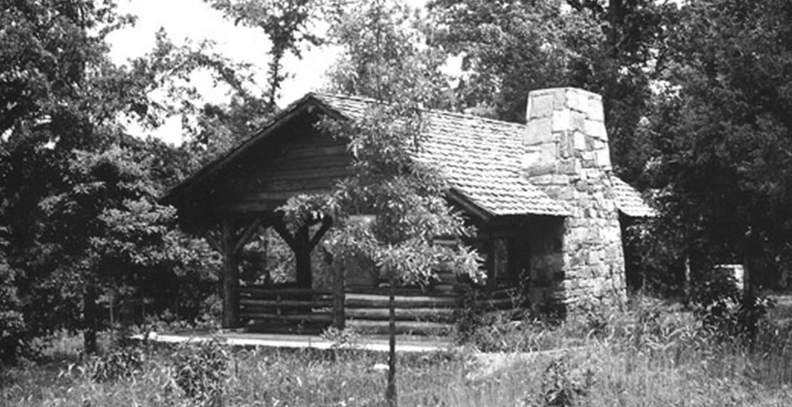
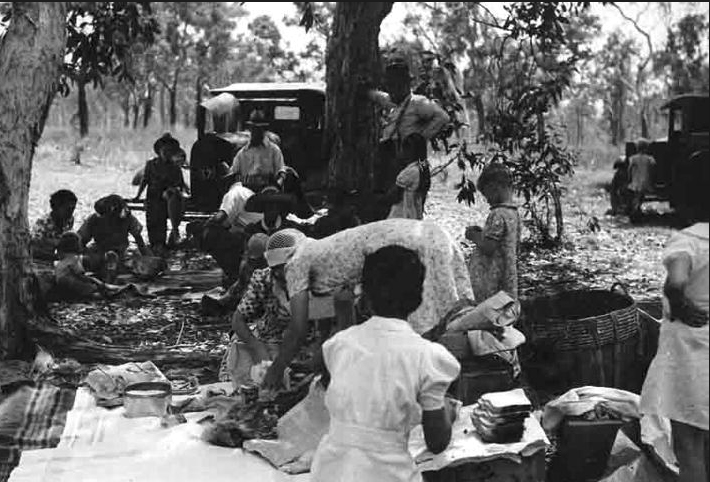
1930s open-style cabin and 1930s informal picnic.
The Sunday Society Section was filled with well-heeled Omahans “Down on the Farm” in 1935. Agriculture and outdoor sports were thought to make rural life attractive. Country entertainment was new sport for the Society Farmer “who wants to be.” I guess an older way of saying a Rural Wanna-Be. His chores were thought to be good exercise. This tradition was no doubt rooted in the country homes of England or the East Coast. A proper home in Manhattan with a farmhouse in New Jersey where one could breathe in the fresh country air. The West Omaha farmhouse or summer cabin would typically be designed as carefully and in a studied manner of one’s city home but suggesting an off-handed, undecorated gesture. A rag rug? Check. A self-assured quilt? Check. A rustic mantle arranged with the signals of an outdoorsman? Check. There was also a whole ritual agreed upon by society women about which weekend one would customarily open one’s summer home in planning for the season. There were also quiet rules about the names of summer houses, seemingly drawn from literature and whimsy. “Dr. and Mrs. C. C. Tomlinson are to be found these days in a cabin tucked away in a big grove of elm and oak trees out on West Pacific. The grounds nearby have been landscaped for future building and the cabin was constructed for recreational purposes. But until the new home materializes, it’s the country place where the Tomlinsons spend their summers and they feel cool breezes…”

OWH 1936. Just some city kids lyin’ around in the country. The fresh country air compared to Downtown Omaha was said to be remarkable.
These clues are priceless and some of the only descriptors of what the Sapling Consumed Couple created during their favorite pastime—planting and caring for the woods. The article makes plain that another building, in addition to the cabin, was in the works forthcoming. I found in my research that their planting diversion was carried out by the Tomlinsons alone. In time they would hire a caretaker and other domestics, such as a cook, but the planning, overall design and planting was their own amusement. More on Dr. Tomlinson’s potential influences below.
The Tomlinson Plan
It is interesting to consider that many in this wave of westward wanderers were upper crust, merely seeking folly in a second home. And yes, there is a great amount of evidence that the Tomlinsons used their retreat for recreation and socializing, that is true. Nellie Tomlinson seemed to find great pleasure in publicly announcing the formal opening of the family cabin for the season, in correct form. But both Dr. and Mrs. Tomlinson seemed to have a much larger plan in mind, one that enhanced the greater ecological good, not just their social standing.
Stepfather of Miss Cassette had suggested Dr. Tomlinson might have taken a tip from horticulturist, Professor Charles Edwin Bessey’s lead (1845-1915). Bessey wanted to enhance the ecology of the Plains and helped to establish the Nebraska National Forest. I would gather information on Bessey from the History Nebraska site. “A native of Ohio, Bessey was a nationally known University of Nebraska professor of botany and horticulture from 1884 to 1915.” Bessey’s accomplishments were many, to include writing legislation requiring land-grant universities to distribute new knowledge and research to the public through agricultural experiment stations, he established one of the foremost botany programs in the country, and developed modern plant classification.
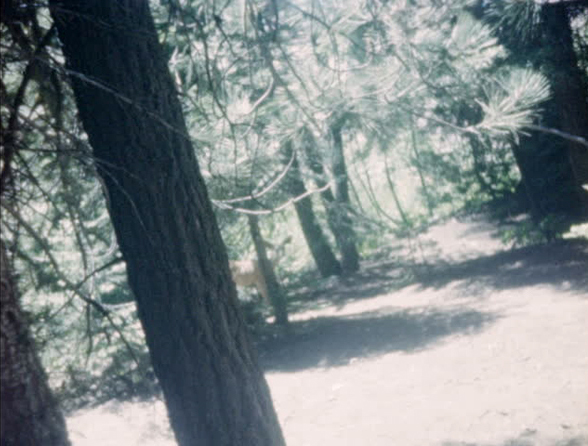
1940s still from a film.
Professor Charles E. Bessey made a lasting impact on the University of Nebraska and our state through his belief in promoting environmental stewardship. “The first suggestion that the federal government should plant trees in the Sandhills came from Bessey in 1890. He believed such forestation would provide a source of fuel and fence posts, help control erosion, and provide sanctuary for wildlife. In 1891 the U.S. Department of Agriculture’s Division of Forestry established a small, experimental plantation of pines on the Bruner Brothers’ ranch in Holt County. This success led to the creation of two forest reserves on the Dismal and Niobrara rivers by proclamation of President Theodore Roosevelt in April 1902. In 1908 the reserves became the Nebraska National Forest.” An article found in the World Herald shed light that the Charles E. Bessey Tree Nursery “delivered nearly 2 million low-cost trees to Nebraskans for establishing windbreaks, shelterbelts and farm wood lots between 1912 and 1924.” I knew after this survey that Bessey was most definitely on Tomlinson’s radar.
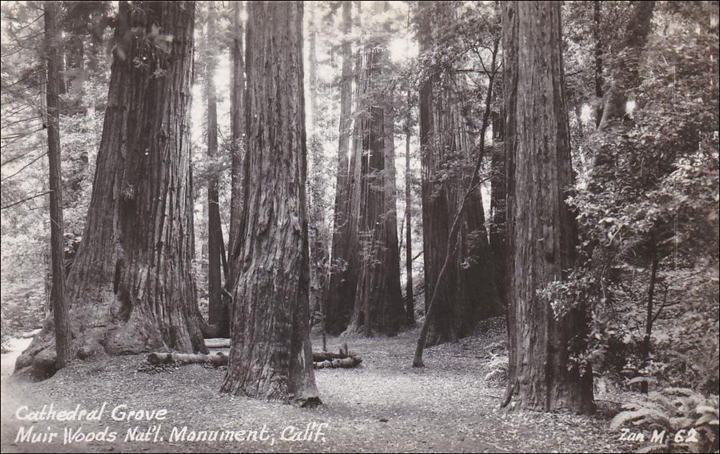
Muir Woods in California vintage postcard.
When I brought up John Muir as a potential (obvious) influence, Stepfather Cassette (kindly) proposed Muir’s associate, Aldo Leopold (1887-1948), possibly had the ticket. Leopold worked as an ecologist in the 1910s-30s and was quite the bellwether, concluding a particular kind of forest preservation should be embraced. His concern was over “the rampant building of roads to accommodate the proliferation of the automobile and the related increasingly heavy recreational demands placed on public lands.” Mr. Leopold coined the term “wilderness” in the description of his preservation concept. By the time of Dr. Tomlinson’s 1930s wooded undertaking, Leopold was the nation’s foremost expert on wildlife management.
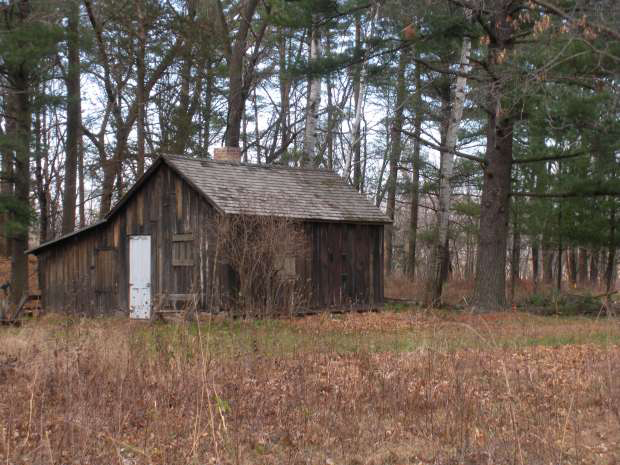
Aldo Leopold’s summer shack as it appears today.
Similar to Dr. Tomlinson, Aldo Leopold would create a family summer retreat in rural Sauk County, Wisconsin in the early 1930s. This landscape was known to have inspired Leopold’s conservation ethic and the writing of his best-known work, A Sand County Almanac. The property is now owned and managed by the Aldo Leopold Foundation, which provides tours and other educational programs on the property and his conservation efforts. In concert with Dr. Tomlinson’s rural upbringing and obvious passion, it would appear that Omaha’s doctor acquired his West Omaha land attuned to the work of these prominent, national ecologists.
In Due Time
Come April, the Tomlinson’s Country Home opening was announced every year, along with all of the other society families’ country homes and cabins. In a great article in the “Society News” from 1936, the World Herald featured wealthy Omahans Down on the Farm. “In contrast to those Omahans who go away, there are the few who enjoy real vacations at home. And fortunate they are, for their holidays last all summer-or just as long as the family chooses to stay ‘out at the cabin’ or ‘down at the farm.’ Among the year ‘round dwellers listed were Dr. and Mrs. C. C. Tomlinson who had “become so attached to their cabin at 114th and Pacific that they move out in May and stay until the last of October.” Little by little they were said to be “building up the home that they expect to have there permanently. This year’s addition was a new barn. They will probably break ground for their house next summer.” It would seem that that house was coming along a little slower than expected.
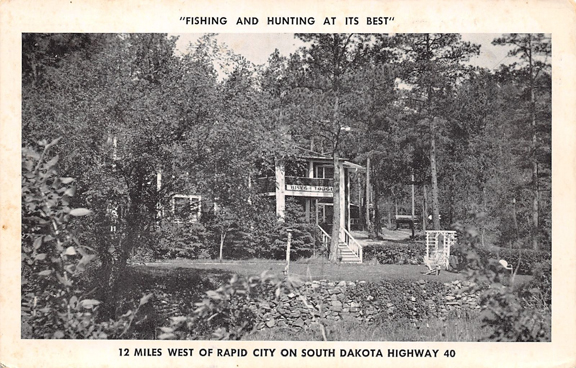
Hisega (Rapid City) South Dakota Lodge nestled in woods. Vintage postcard. I only share this for cultural context.
A 1937 sale out at the Tomlinson cabin was telling of their large operation and possible distraction from building that second home. “A Fairbanks windmill, like new 10-foot wheel, 40 foot tower. New horse drawn lawnmower, 32 inch cut. Delco shallow well pump and Delco automatic light plant engine. Power lawnmower, 30 inc.” I was surprised to find that the Tomlinsons owned much farmland in our region and parcels sprinkled all around Omaha. So these various farm sales Dr. Tomlinson would have on occasion might have been used on other properties.
And indeed I was delighted to discover what looked like a rooftop within the 1938 DOGIS aerial photograph.
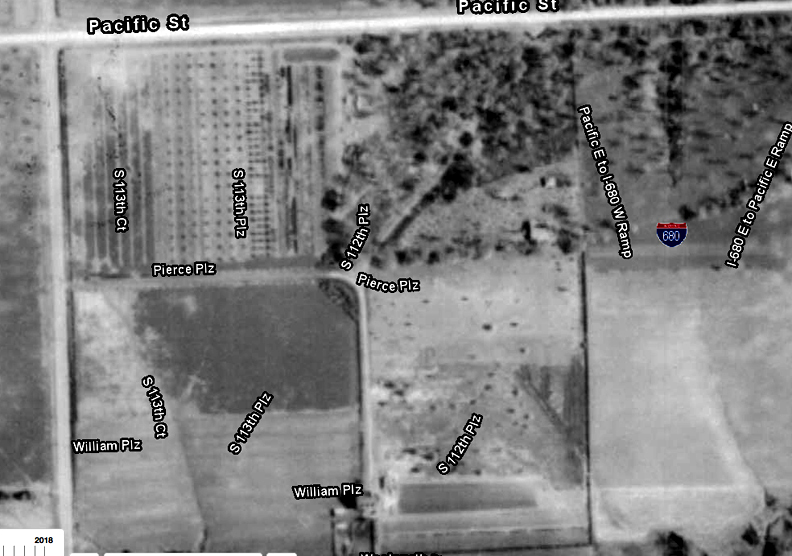
Is there a cabin present in 1938 aerial? Aerial photo from the Douglas County/Omaha NE GIS Department mapping site. One can see the very planful rows of trees on the northwest corner of the lot. There are, what appears to be, two buildings in the eastern portion of the Tomlinson property. I-680 had not been built at the time of this photo, but one can observe where the hard property line was between the Tomlinsons’ and the Rohwers’ on the east.
There were a number of parties held on the property outside of the formal opening and closing of the cabin. For example I would discover Miss Bunny Tomlinson threw an annual “Hard Times Party” every December out at the Tomlinson country home for her Northwestern University friends throughout her four years in attendance. What is a hard times party, you ask? Mother and Stepfather of Miss Cassette thought it was probably a themed party where people dressed up as “hobos” and “poor Depression era” folks. Can you imagine? Meanwhile Dr. Tomlinson and a group of doctors had formed the “Off Night Club,” where they drank and caroused out at the Tomlinson cabin on free nights, even in the winter. The “mink-coated throngs” of all of Omaha high society found amusement in January of 1937 to bid at the vaguely described auction “of one of Omaha’s loveliest old homes.” I would find the Tomlinsons seated amongst the rare bargains, billowing blue smoke, artwork and mattresses “As Dr. and Mrs. C. C. Tomlinson bid, they ever kept in mind the house they plan to build next spring on West Pacific Street.” What treasures did they amass?
The Best Details
I had committed myself to finding the source of the bell. Such was the hidden wood, when I entered into this silly contract. And here I was, all-a-quiver and at its mercy. I would find the best photo of the lot and an article of delicious dish.
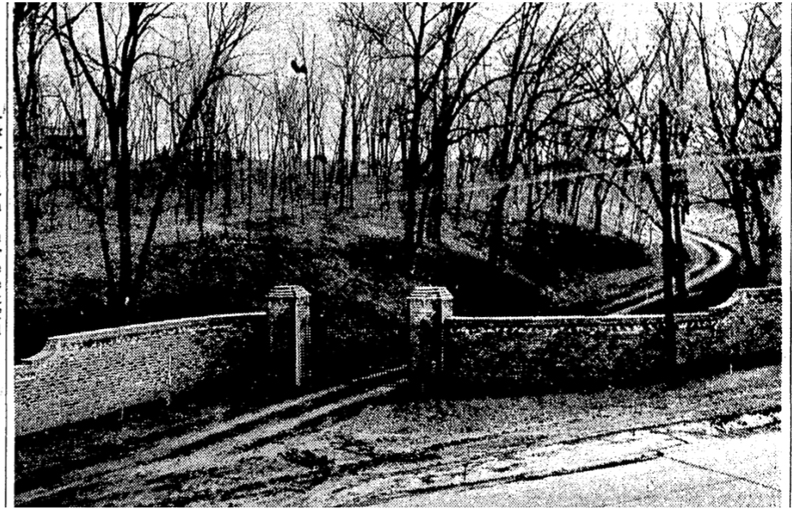
OWH 1938. This savory photo reveals the original entrance to the Tomlinson country home, on the Pacific Street side. This was the north entrance to the woods. I adore the way the formal entrance cuts in at an angle. The meandering tire track path and is that a house in the distance? This black and white image couldn’t be any more enticing…and a little haunting. My favorite combination.
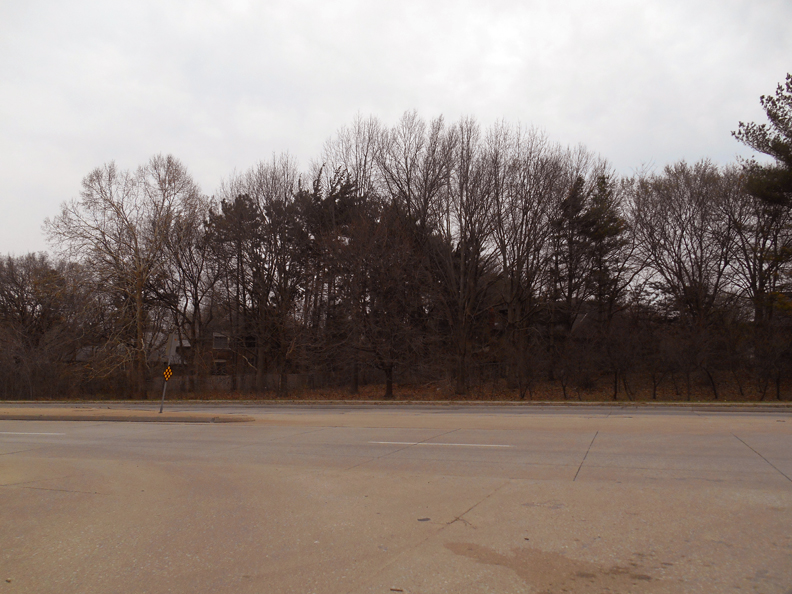
This current photo shows the approximate historical entrance as it appears today. Of course Pacific Street is a wider, much busier affair these days and trying to enter the woods at this site would be more than dangerous now. Near impossible.
Dr. and Mrs. C. C. Tomlinson’s hobby “west of the Happy Hollow Country Club” was humorously coined a kind of “terrestrial dermatology”. They were said to have acquired the land, then a cornfield and patch of timber, followed by seven lean drought years. “Yet they have managed to transform it into a most attractive spot.” Entrance from Pacific Street is through an iron gate, flanked on either side by a massive and artistic brick wall. Then the paved road winds through a tree-lined ravine, once quite deep, onto a slightly landscaped knoll, where the Tomlinson expect that at a future date they will build an English-type house. To the southeast is a sweeping view, in which the gaily-colored Happy Hollow Club looms as the central object. Buildings on the tract at present include a comfortable, roomy, summer cabin, complete with shower bath, cyclone cellar, mammoth fireplace, hot water heater and pair of handsome mounted muskellunge; and a three-story brick barn, painted white, with five box stalls, tack room and modern apartment for help. A circular area has been landscaped for a proposed swimming pool and among the other ‘musts’ are plans for a tennis court and a greenhouse close by the home to be served by the central heating plant. Landscaping probably is the most interesting development to date and has demanded the most work and attention. The Tomlinson are doing the job to suit themselves, only. In their own nursery they are growing: Austrian, Scotch and white pine and several thousand Chinese Elm; Juniper, Spirea and Arbor Vitae; Hackberry, Russian Olive and Lombardy Poplars. More than that they have several hundred fruit trees, of which apricots are already in bloom and a variety of berries, on thousand grape vines and a big asparagus patch. During the last few years the drought has killed their native trees, especially Elm, Walnut and Oak by the hundreds. They have found that Hackberry and Russian Olive best stand the test. That they have been able to save as much of plants and trees as they have is due largely to a 150 foot well, which apparently tapped a limitless supply of water. A pumping system forces the water to hydrants all over the place.”
I was beside myself. A three-story brick barn? A proposed swimming pool, tennis court ad greenhouse. Glory Be.
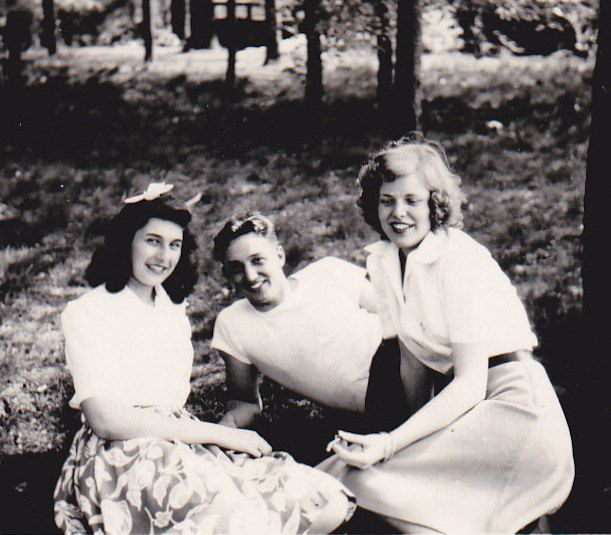
Cries for Help
I began to think this was no small cabin affair. The Tomlinson property would soon have its own staff. My proof was in an odd but fascinating tale. I read of the kidnapping of Frank Palladino, secretary of the Goddard Fuel Company. The bandits would overtake Palladino by gunpoint and use his car to rob the safe of Farnam Liquor House at 2401 Farnam. The men forced Palladino out into a cornfield on the northeast corner of 114th and Pacific, directly north of what we now call Tomlinson Woods, where they bound and left him in the cold. “Trussed with a length of clothesline that one thug took out of his pocket,” Palladino’s cries for help “awoke an employee on the nearby Dr. C. C. Tomlinson farm.” The Tomlinson staff called the authorities, who freed Palladino; his hand and feet were numb. Aside from the horror of being left in a cold field, it is strange to think of desolate time when one could have heard a pleading voice floating across Pacific Street. The perilous event also sheds light that a Tomlinson caretaker potentially lived at the property.
I became obsessed with the idea of a separate staff living out at 114th and Pacific while I know from the census and other advertisements that the Tomlinsons also hired domestics at the Dundee residence. It was not hard to gradually work myself into full midnight knitting attire. Mrs. Tomlinson frequently ran ads for cooks and maids for the cabin. Dr. Tomlinson ran an advertisement for a married Nursery Man with experience to live on premises in modern living quarters in 1944. In 1945 they asked for a married couple-a yard man and cook for year round work with separate living quarters. I began to wonder if the Tomlinsons had completed that house yet? It would sound that way. To my calculations there was a cabin, a storied barn and staff living quarters. And what of this nursery man? Were the Tomlinsons running a full-fledged nursery with all of those trees?
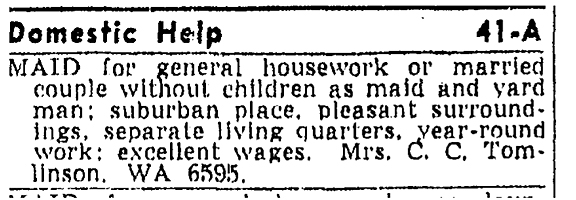
OWH. July 1943. Year-round maid.
A Mystery Nursery Business
I had found hints of Evergreens being sold from the vague 114th and Pacific location for years but was not entirely sure they were a Tomlinson venture until this little gem of an advertisement.
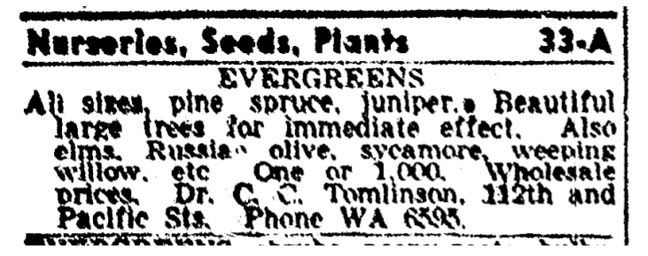
OWH Sept 1943. So he was running his own private nursery of sorts.
Further more, another clue lifted from a wonderful memory of an ex-pat Omahan: “For years before we left Omaha, Dr. Tomlinson would take us out to his lovely estate on West Pacific Street and we would wade out into the snow and cut our own Christmas tree while he stood their smiling like Santa Claus in person.”
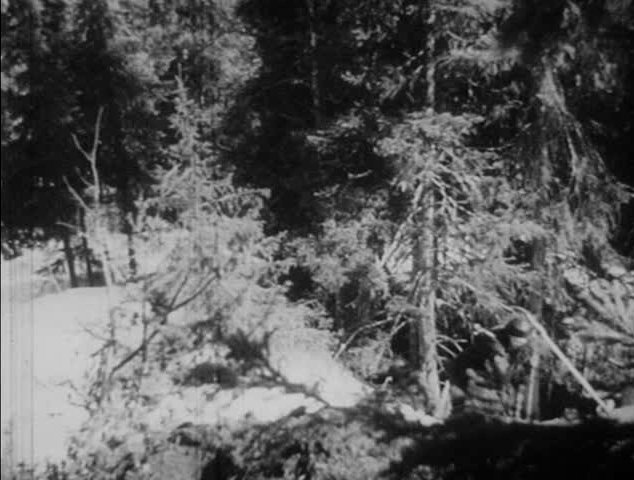
A caretaker, deep into the future of the Tomlinson tale, would shed light, stating that much of the Tomlinson’s time was spent creating a garden “containing most woody plants which grow in Nebraska.” There was a meadow and forest paths to wander. Only the strong species survived through the drought of the 1930s. Dr. Tomlinson drove to his site day after day “to water and prune and spend hours relaxing with his family in a cabin or the carriage house.” Every tree was planned with care; decades later a state forester would identify 81 species after a two-hour inspection, saying that were just a portion of the woody plants growing. He estimated 200 more varieties living in Tomlinson’s wood. Later still another Nebraska Arboretum professional would deem Tomlinson’s manmade wood the most varied planting of species of trees and shrubs that grew in this region. Nebraska was said to have no other site containing such a cross section of plants. Families of foxes, deer, raccoons and thousands of birds called the wood home as well. It was an expansive accomplishment.
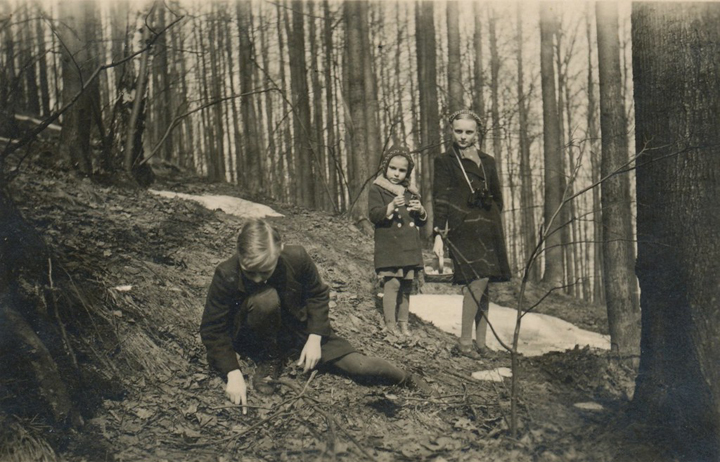
A whimsical article found in the 1946 World Herald described the Tomlinson country residence. The journalist elaborated on drawing up “before a gate at 112th and Pacific Streets Sunday afternoon.” The traveler ascended “a driveway which wound through a wooded and wild-flowered ravine and stopped before a neat but by no means pretentious dwelling. The sweep of lawn stretching away to the east, north and south and dotted with every different kind of tree I have ever hear of or ever expect to hear of, surpasses even my rugged powers of description.” The writer would spend the next two hours walking with Dr. and Mrs. Tomlinson “over 40 acres of fairyland.” He elaborated on perfect details such as flowers, shrubs, trees, grass, two cream-colored horses, a spotted pony and colt, a spotted cow and calf, butterflies. Complete with the best sentence on earth: “It is a lovely spot, the fruit of Dr. and Mrs. Tomlinson’s dreams and largely of their hands; a sweet-scented reminder that the only truly abiding beauty in this world will be found nestling close to the bosom of this, our Mother Earth.”
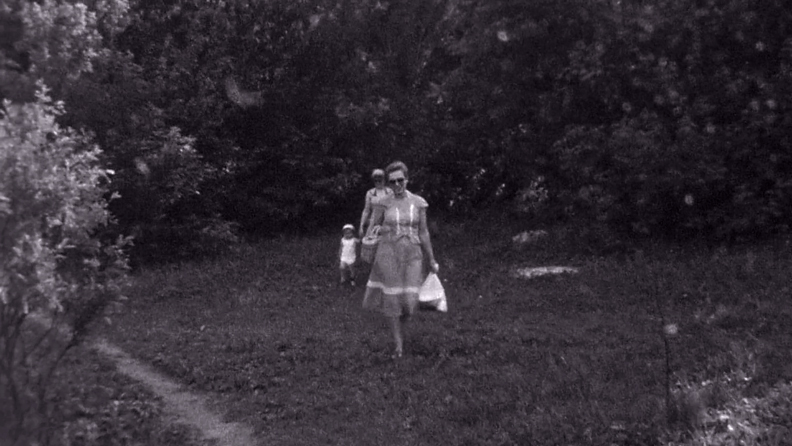
1940s Photographic Dossier
In 1941, the United States was just beginning to come out of the Great Depression and everyone most assuredly was looking forward to better times. However World War II meant the beginning of more hardships with citizens being urged to fight on the “Home Front” as well. Slogans such as: “Use it up, wear it out, make it do, or do without” and “If you don’t need it, don’t buy it” were brought back into use. It is interesting to consider how these times effected the wealthy of Omaha, entertaining in their second country homes. Vegetable gardens and farm animals became very popular as even the weekend country folks wanted to do their part—at least in the Social Pages. By the Pearl Harbor attack, only one-third of rural Nebraska had electricity. Only 25 percent of farms had telephones. The home front in Nebraska, like the rest of our country, felt the war in a profound way. The Tomlinson wooded area garnered much attention in the 1940s press and I’ve got to think it offered regular folks a brief dreamland as well. Here are the photo archives.
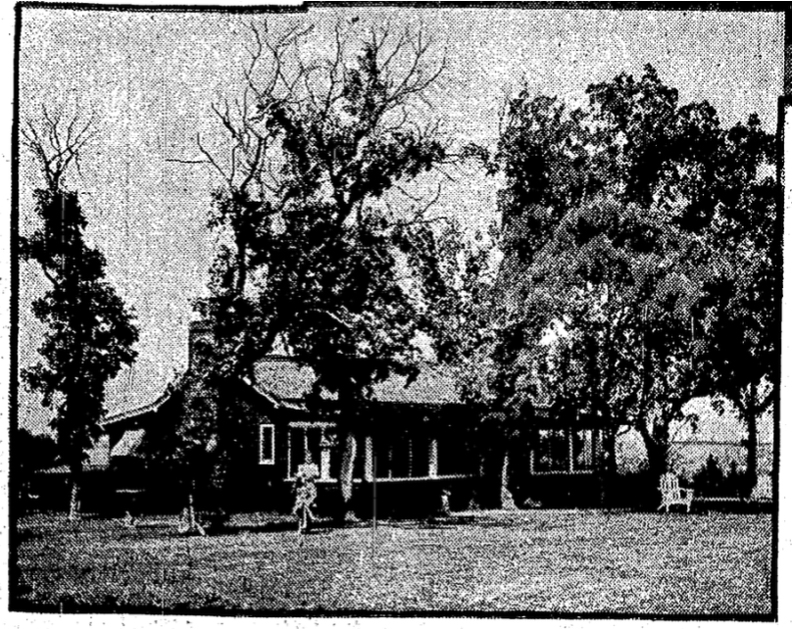
OWH 1940. Tomlinson summer home. “The Dr. C. C. Tomlinson summer home is hidden in the trees several miles out on West Pacific Street.” The moment we’ve all been waiting for. “Popular retreats from the heat of summer are the cottages and summer homes Omahans have built in surrounding countryside. Pictured here are a few of the many dwellings found outside the city.”
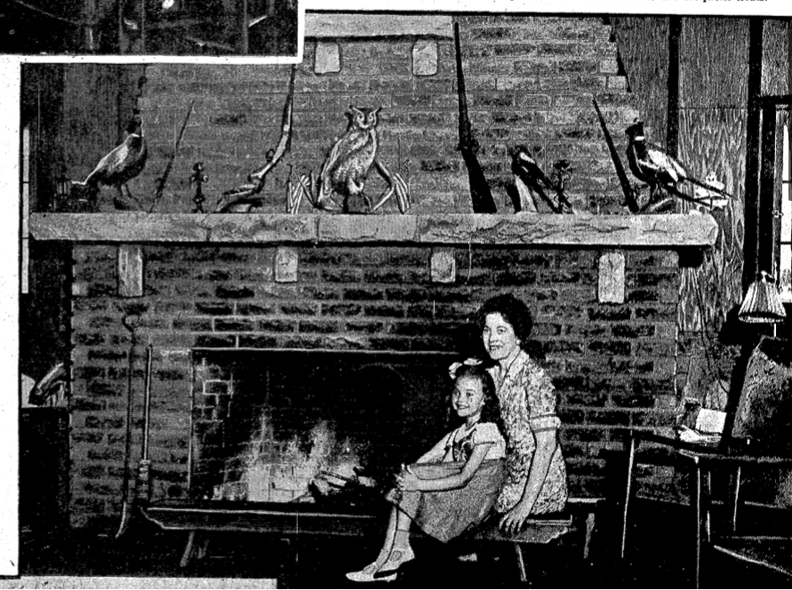
OWH 1940 fireplace. “Pictured with her grandmother, Mrs. Tomlinson, is little Miss Elizabeth Davis, here from her home in Texas, with her mother, Mrs. William E. Davis, Jr.” Just take it all in. Make a mental note of this fireplace, as I believe it is place of interest. This is possibly the missing chimney I mentioned earlier. “She’s strong for Old Glory. Bright and early every morning, little Elizabeth David, 6 assists in flinging the huge American flag to the breeze.”
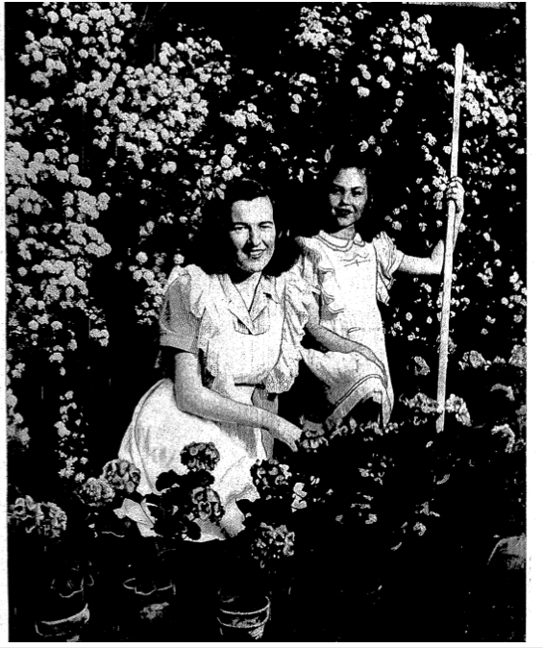
OWH May 1941: “Setting out geraniums these gardeners attired in pinafores are Miss Elizabeth “Bunny” Tomlinson and her niece, little Miss Elizabeth Davis, who finished out the school year here. The gardeners are at the summer place of Dr. and Mrs. Tomlinson on West Pacific Street.
The Aerial Map Clues
The 1941 and 1955 aerial maps of the Tomlinson wooded acreage are hard to discern. But pore over them, I did, enlarging and scheming. Was there a historic building that could be matched up with an extant structure of today? I was never quite clear of how many buildings were on the land. There was a summer cabin and large multi-storied barn. Were there additional servants’ quarters or had the barn been converted?

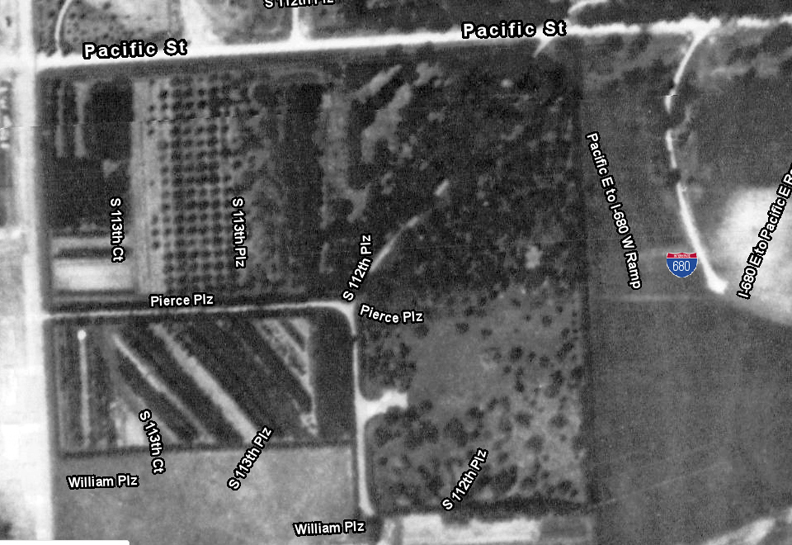
1941 above and 1955 below. Both aerials from the DOGIS site. Was there a cabin on eastern side? No I-680 yet.
A building looked to be on Lot 86, block O of 29-15-12 section township-range parcel # 2326347170. The “S” family, of Burger King franchise fame, now owns the three lots on this corner. The potential cabin image is evident through the 1973 aerial but by 1982 it has vanished. By 1986 the home on this lot sold for one of the highest prices paid for Omaha residential property at that time, a whopping $825,000.
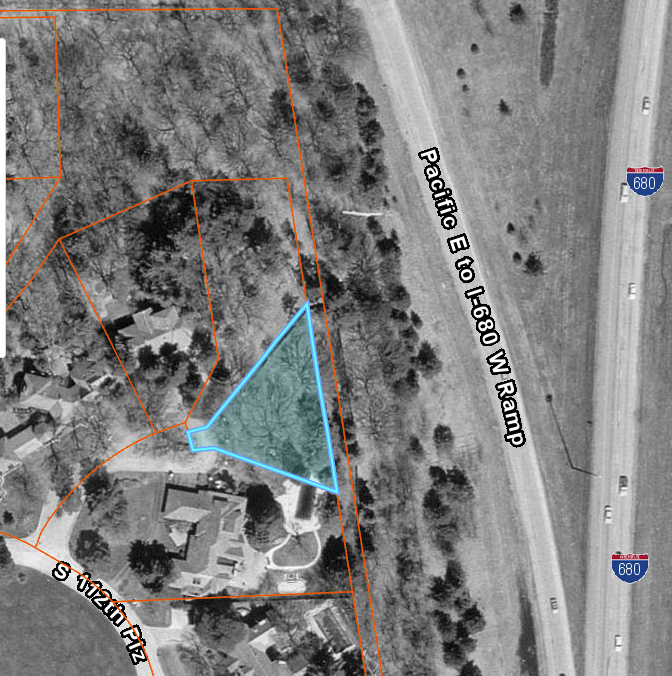
Detail from the Douglas County Assessor’s site.
Or was this faint image of my imagination just an outbuilding? Upon review of the historic aerials that I’ve shown previously, the drive up the Tomlinsons country estate appeared to cut diagonally across the east portion of the land, to a central area. There appeared to be a home, or I should say, a structure located at this same point through all of the aerials. Parcel Address: 11211 Pierce Plaza is in question. Currently positioned on 1.27 acres, at 8,557 sq ft, this gorgeous, mammoth, Tudor style home was supposedly built in 1983. It sits very comfortably in the Center of what we now call Tomlinson Woods. Check. Of intrigue, it has a handsome placard on its front brick gate that tempts: “Tomlinson House.” Big Check.
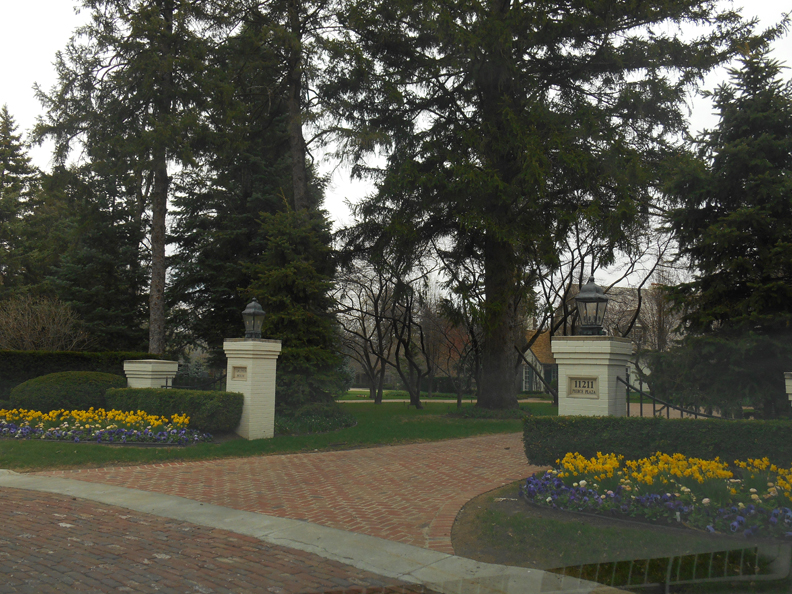
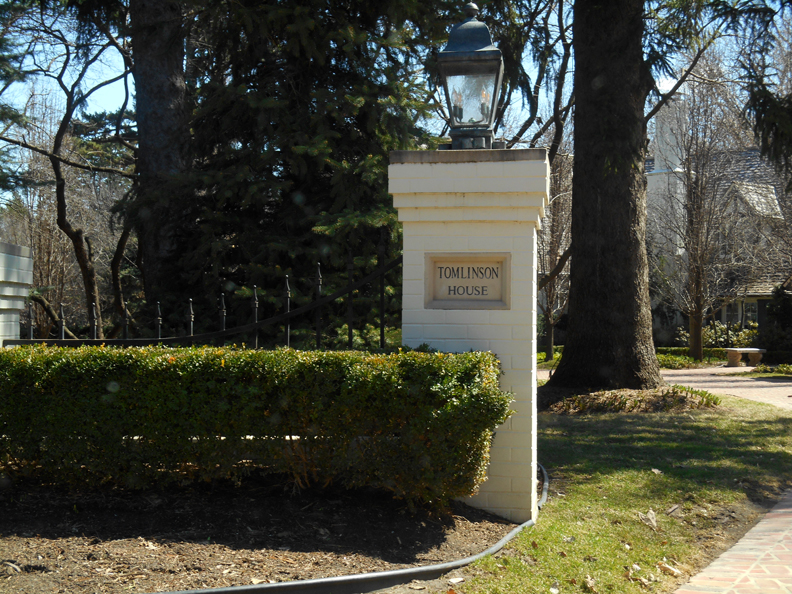
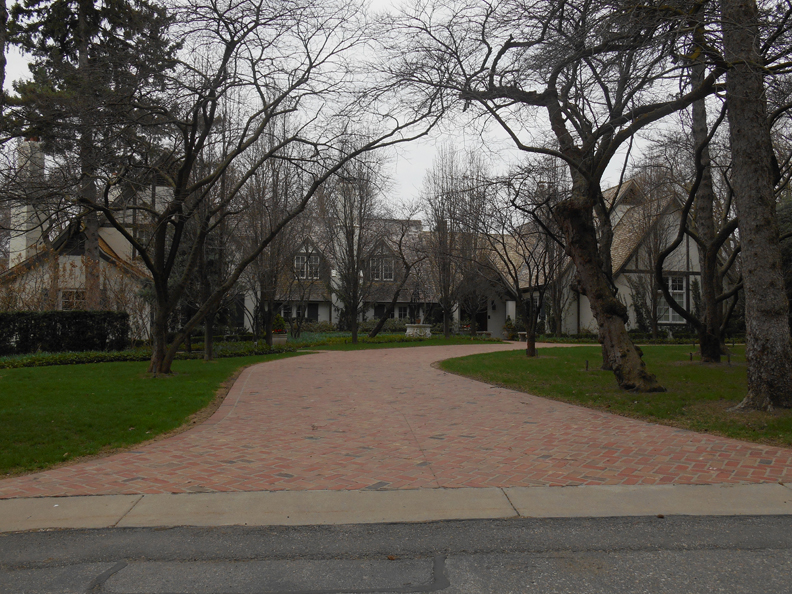
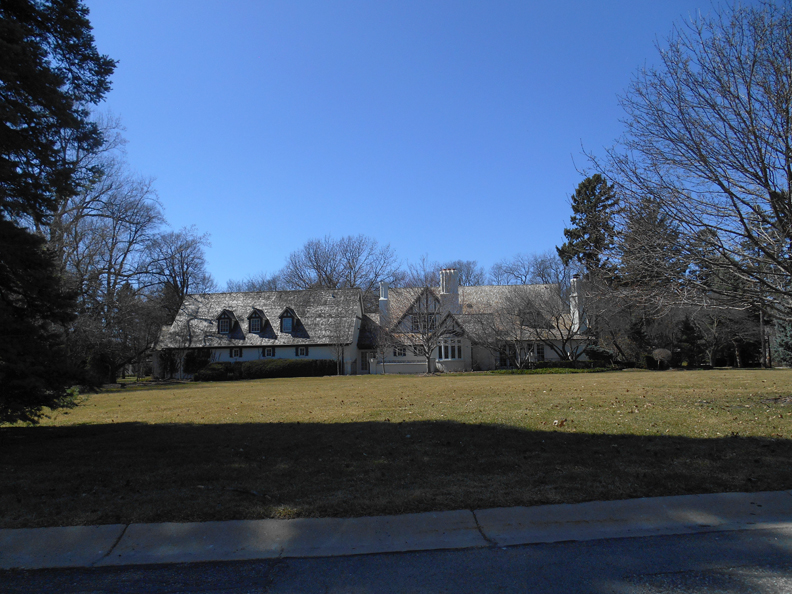
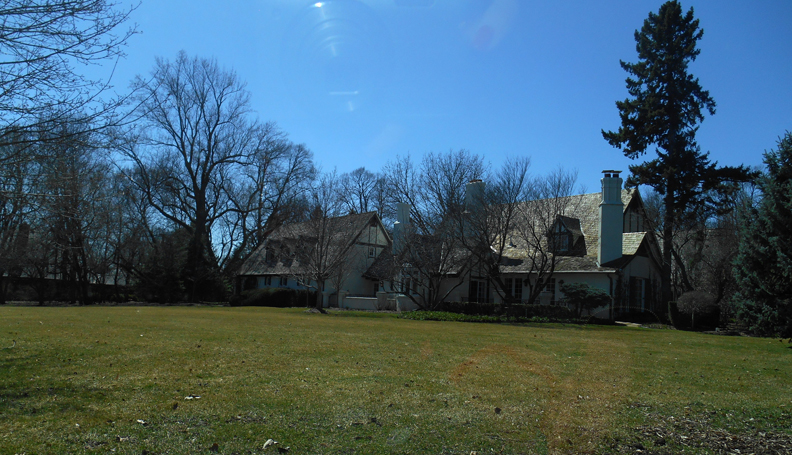

Was this glorious abode a part of the original Tomlinson cabin or house or barn? It features many chimneys, all of them massive enough to support the wide, rustic, stone fireplace that Mrs. Tomlinson and little Elizabeth had posed in front of, encircled in this magnificent home.
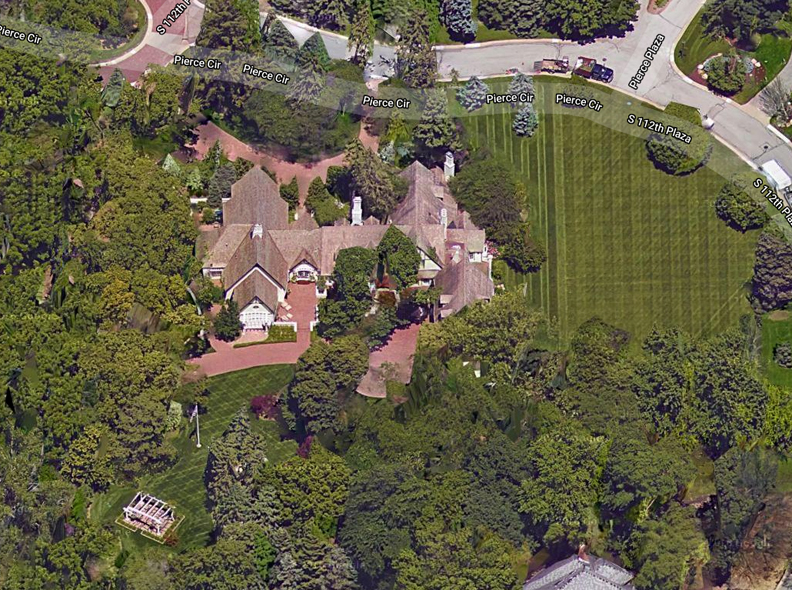
Photo from the Virtual Globetrotting site: The “B” family, of Valmont Industries acclaim, have made additions to this home since purchasing it in 1994. Of note a family member was once interviewed in the family’s “refurbished carriage house” in Tomlinson Woods. Could this have been a portion of the original property? I dreamed it had to be the barn turned servants’ quarters where the caretaker lived!
Deaths in the Area
Neighbor Anna E. Rohwer, just south of the Tomlinsons died in 1943 at the age of 90. She still lived there at time of death. Her son, H. B. Rohwer died at his home, to the east of the Tomlinson in January of 1946. In July of 1955 Dr. Charles Tomlinson died out in his wooded estate, after a day at the office, according to his partner, Dr. Olin Cameron. “Although he had suffered a similar attack three years ago, Dr. Tomlinson had maintained his practice.” He was only 70 years old.
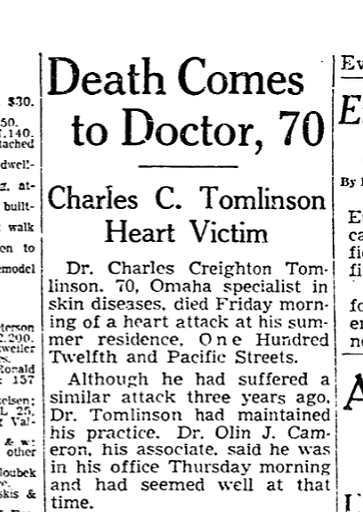
July 1955. Dr. Tomlinson is buried at Forest Lawn Memorial Park. Charles C. Dennie, M.D. wrote a lovely obituary, which was published in January of 1956.
Housing Pushes Westward Again
I had to wonder what Dr. Charles Tomlinson would have thought about all of the Omaha suburbs moving in along his wooded oasis. When I found a clue, upcoming, I figured he must have seen the writing on the wall and was at peace with it, ultimately. In 1954 Mrs. Archie Fulton announced that 160 acres near 114th and Pacific has been purchased for residential development. 80 acres near 120th and Pacific, owned by her husband, was also to be developed. Mr. and Mrs. George A. Rohwer had already moved to Elkhorn after having farmed for 41 years at 114th and Pacific, at what is now the Skylark Addition.
According to a January 1955 OWH article, sixty Omahans would band in a co-operative to develop the Skylark Heights Association. The group purchased 160 acres from Mr. and Mrs. George A. Rohwer for 175 thousand dollars on the southwest corner of 114th and Pacific, caddy corner from Tomlinson Woods.
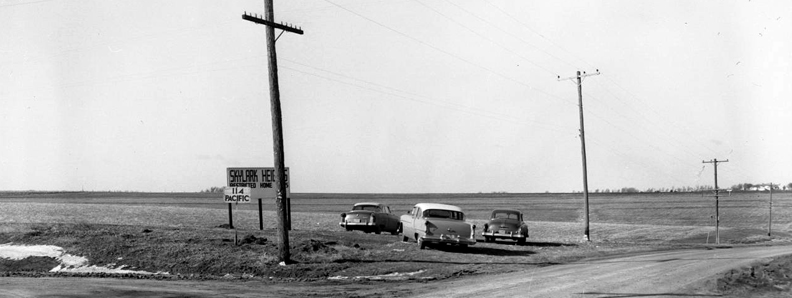
Skylark Heights Restricted home sites. 114th and Pacific. Three automobiles are parked at a land clearing. Creator: Savage, John (1903-1989). Publisher: The Durham Museum. 1955. This photo gives a good idea of how flat and almost barren seeming the land around the Tomlinson country estate was.
In March of 1955 homebuilders Glenn Timmons and John Bilby purchased a 116-acre tract north and west of 114th and Pacific from Dr. and Mrs. Tomlinson for 175 thousand dollars, to be developed into a subdivision called Meadow Lane. The pair planned to create about two hundred lots for the new neighborhood. This meant that months before his death, Dr. Tomlinson had sold a good amount of additional land. It would appear he had bought some of the Rohwers’ land as the years went by.
Misfortune
With Dr. Tomlinson having died, I wondered how often Mrs. Tomlinson made it out to their 40 acres from her home at 5215 Jackson Street. As is often the case, when a person passes away and property is viewed as abandoned or falls into disrepair, vandals can encroach. It might have been that the Tomlinson land was very well cared for and that the times were simply changing. After all with the abundance of subdivisions coming into the area, there were all kinds of new lookey-loos driving about. No doubt, many were curious about the glorious wooded land beyond the bricked gate. Also I’ve got to think with the rise of teen drivers, after World War II, that pranks and mischief also had a hand in the future problems of the private wood.

OWH September 1959. Vandals hit in a very strange turn of events. The interior of the home “was damaged and maid’s quarters entered, deputy sheriff reported. Deputies said the vandals smashed fuses, then apparently worked by candlelight. They also cooked sweet corn taken from an ice box and ate it while they smashed articles about the house.” This definitely sounds like teenagers to Miss Cassette.
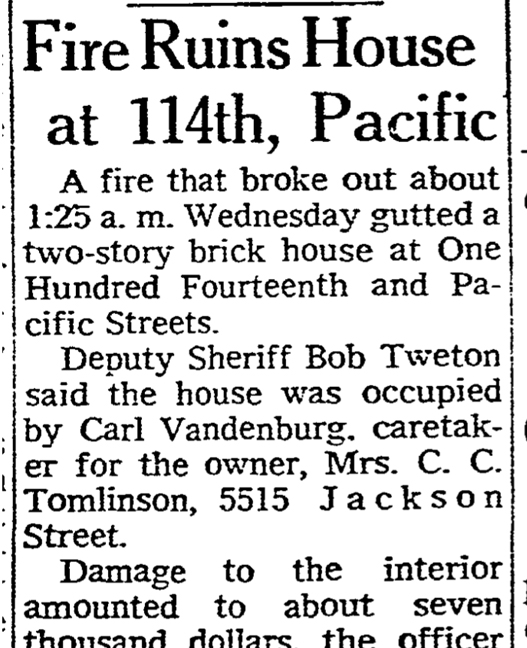
OWH 1960 Fire Ruins House. A fire broke out about 1:24 am, which gutted the two-story brick country house of the Tomlinsons. Carl Vandenburg, caretaker for Mrs. Tomlinson was living in the house. Damage to the interior amounted to about seven thousand dollars, the officer said. Furniture and plants stored in the building were valued at about five hundred dollars. The deputy said the fire apparently started in the ceiling near a chimney. Was this our fated proof that a house was eventually built?
1960s, Vandals, Rumors and Speculation
Miss Bunny and Miss Margaret, then called Mrs. William E. Davis, Jr. would continue to return to Omaha into the 1960s to visit their mother, spending the summer at the Tomlinson Country Home, “as is annual custom.” From what I could find, the gracious buildings on the land would continue to be vandalized throughout the following decades. There were also growing rumors of the large swath of land being an “Albino Farm,” perhaps fueling the vandalism.
But before we get into my strange attempts to track the urban legend of the Tomlinson Woods “Albino Farm”, let me share my thoughts. Albino is a slur term for Albinism, a genetic, inherited condition that causes little to no production of the pigment melanin. People diagnosed with Albinism or people with Albinism is the correct terminology. Albinism is often visible in a person’s skin, hair and eye color, appearing very pale. This can cause vulnerability to sun exposure and secondary health issues such as blindness. Although rare, genetic Albinism affects people worldwide, regardless of race, ethnicity or gender; I would learn albinism is quite common in sub-Saharan Africa with children and women facing extreme violence and death due to cultural views of their magical powers. People with Albinism often face social and cultural challenges, as the condition is often a source of ridicule, discrimination, and violence.
To learn more about Albinism awareness: http://www.ngopulse.org/article/2017/06/14/albinism-tackling-myths-stereotypes-and-superstitions
https://www.albinism.org/information-bulletin-what-is-albinism/
“The Albino Farm” Rumors
As I stated earlier, I will use the term “Albino” when referencing the rumor, as it is historically accurate to the storyline but I am open to suggestion if there is a better way to handle this phrasing. From what I could gather, it would seem that the “Albino Farm” gossip of Tomlinson Woods most likely began in the 1950s or 1960s, perhaps earlier. Across town in the 1950s there were also rumors about Hummel Park being home to an “Albino family.” The large, rolling park is situated on 202 acres of land located at 11808 John J. Pershing Drive in North Omaha. By the time I was in grade school, attending Hummel Park Day Camp, that folklore was in full swing—and that was in the 1970s! I spoke with a younger cousin, twenty years my junior, and she too believed there was an “Albino family” living out at the Hummel Day Camp. Nationally there appeared regional legends of groups of people with albinism living together on a farm or even trapped in a hospital setting, often subjected to experiments by a mad scientist. In many of these stories, the people with Albinism were supposedly roaming the various properties by night, scaring trespassers. One only has to sit for a few seconds with this legend to hear how ridiculous it sounds. Was this a way to vilify and create a local Bogeyman? Or was there a person or persons with Albinism who had been ostracized and lived in one of these outskirt communities in Omaha?

An earlier version out of New York was divulged in Myths and Mysteries of New York: True Stories of the Unsolved and Unexplained by Fran Capo. Capo outlined that the Buckhouts family of the late 1800s were “holding a group of albino slaves captive at a nearby farm.” When the youngest Buckhout daughter freed the slaves and killed her family, a manhunt for the “albino slaves” ensued.
The “Albino Farm” legend was the topic of Steve Yates book of the same name, focused on a Springfield, Missouri case. Springfield’s rumors also led to many high school hijinks, shortly after World War II. In their version, the farm was deserted by its former property owners and had become home to a “scary albino caretaker.” Yates also tracked an additional storyline where the “Albino Farm” was home to a sequestered group of people with albinism. Very much like the Omaha Tomlinson country home experience, there were many negative consequences of the “Albino Farm” legend. Young people “were trespassing and raising heck and tearing things up and setting bonfires and doing ridiculous things,” Yates said. “The sheriff’s office was coming and pushing them out of there.”
There is also California’s version: The “Albino Colony of Hicks Road.” People living with Albinism as well as those who live around the Hicks Road would like the rumors to die off. The “evil” or scary stigma hyped by this local lore only further reinforced the isolationism felt by those with Albinism. The community around Hicks Road also felt harassed for decades by the daring teens driving out to the area at night to explore. Just like the Tomlinson case, trespassers would leave messes and even destroy property.

The Tomlinson Legend
Mr. Cassette’s Uncle Craig graduated from Westside High in 1974. Those were the days when athletic, young lads from good homes tore around town in great cars, looking for high adventure in a seemingly carefree time period. If they ran into trouble or were the cause of said trouble, there didn’t seem to be a lot of hell to pay. I have often thought this generation ruined it for the rest of us! Uncle Craig told a tale of being down in Towl Park drinking with Westside buddies when the Omaha police pulled up. The cops apparently said something to the tune of, “Boys, go on home” but first made the teens open every can of beer and pour it out in front of them. Methinks that had to have hurt and yet those were very different consequences compared to today.
Uncle Craig remembered driving through the Tomlinson property with friends. To his memory there was only one road through the woods. A buddy of Uncle Craig’s said, “I drove a ’65 Plymouth Fury with fins on the back in high school. We always talked about jumping the fence to the ‘Albino’ Farm but there was a story about someone jumping the fence and supposedly was never seen again so we were too scared. Couldn’t get enough beer down us to gain the courage.” Aunt Terri hadn’t thought of the Tomlinson legend in a very long time but remembered the rumors of the Albino Farm.
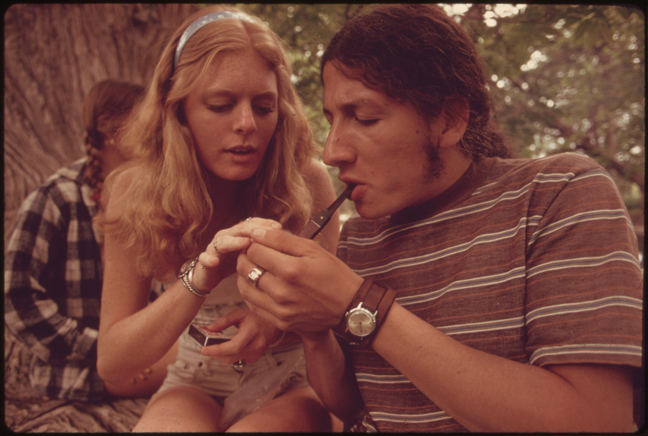
Mother of Mr. Cassette certainly didn’t remember the Albino Farm but did have strong memories of a daydream drive through the wooded area. “We drove around the Tomlinson property when there was a just a farmhouse there. We were trying to find land to build a house on in the early-to-mid 1970s. It seems like it was in the middle on a hill overlooking I-680.” When I asked her it there were actual parcels for sale in the wooded lot, she answered, “We were just dreaming.”
Harry, now 70-ish years old, explained that the Tomlinson Woods “Albino Farm” is where they would go to make-out back in his high school years. He believed there were three rumored “Albino Farms” in town. From what I’ve been able to dig up, the gossip surrounded Hummel Park, Tomlinson Woods and an old hunting lodge in the Ponca Hills area. There are similar characteristics to these seemingly abandoned, wooded areas, making them prime for teenagers wanting a thrill and an escape from peering parents. Also I believe teens, post World War II, had newfound freedoms, access to cars, creating their own culture. This opened up the whole city to them. Driving across town to a remote, spooky area was the teenage version of the Haunted House legend.
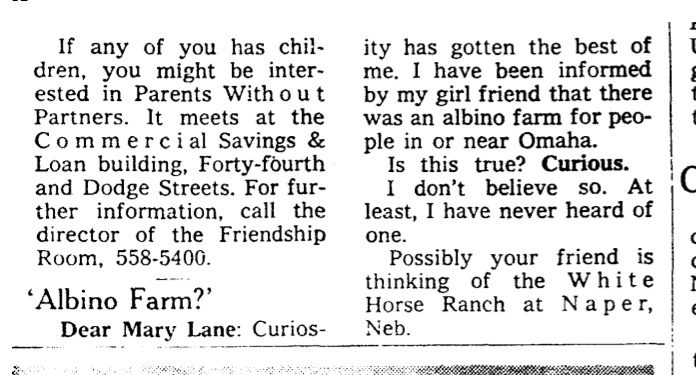
OWH 1966. In 1966 an Omahan wrote in her “Albino Farm” query to a real professional in the form of Dear Mary Lane, signing it “Curious.” You were not the only one.
Theories
From what I could sew together, there were various tales that could connect Albinism to the Tomlinson property.
Upon Dr. Tomlinson’s death, Nellie, his wife would not have been able to manage that big place by herself. Likewise Margaret and Bunny Tomlinson were left to manage the family’s considerable holdings, as well as all of the nearby land they also owned. One story, which may or may not be true, is that the Tomlinson sisters or their mother hired a caretaker with Albininism. Did his job entail shooing away the many young people who trespassed onto the property to drink or park? Or maybe the teens were there because they couldn’t resist a dare linked to “The Albino Farm.”
Another version of the tale, although as un/believable as anything else, is that Dr. Tomlinson treated clients with Albinism in a private clinic on the grounds. He was a dermatologist, after all. Would his clients with Albinism have felt more comfortable in this lush setting, away from the city? I found absolutely no proof of this, but that means next to nothing. Maybe one of our readers holds the clue.
Let us not forget the “Albino” swine or even “Albino” cattle option–as animals were potentially kept on the Kuehl and Rohwer neighboring farms. In the 1930s there were quite a few articles about an “Albino” bird seen in Omaha. Did this rare bird make his home out on 114th and Pacific?
The “Albino Farm” of Tomlinson Woods seemed untraceable and perhaps more based in local legend, prejudice and the desire to create a Bogeyman.
1960s and 1970s Maps
Because I love maps and cannot seem to contain myself, I display the below aerials. On them, you will hopefully find the buildings I have been muttering about. I woefully circled sites of interest on the 1973 map, which probably destroyed its beauty by many archivists’ esteemed point of view. I am sorry.
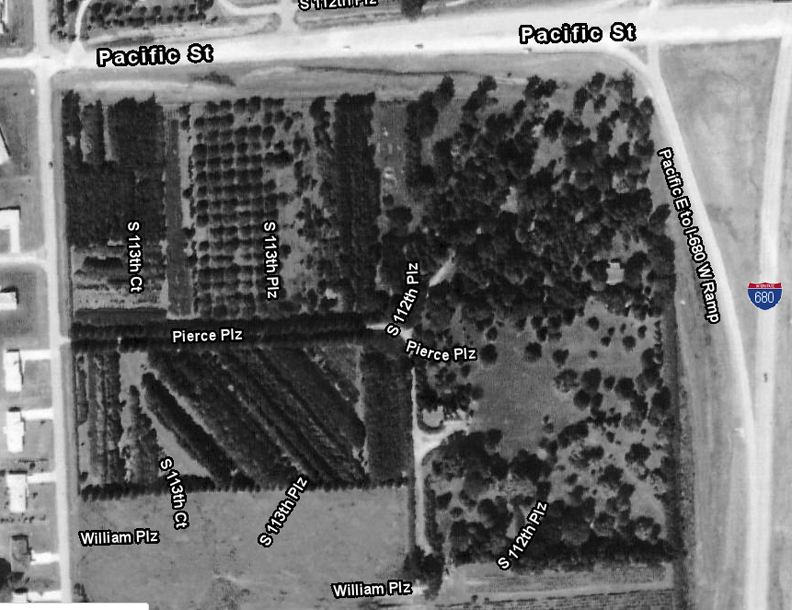
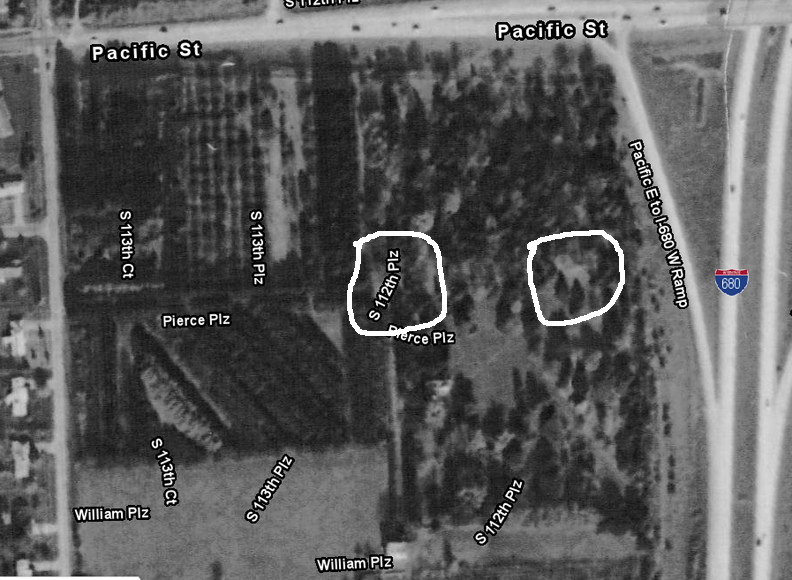
Top image: 1962 aerial from the DOGIS site. I-680 has been constructed on the eastern side of the Tomlinson property. I-680 in Omaha was originally designated Interstate 280. Maps from the early and mid-1960s showed I-280 in Omaha. Bottom image: 1973 aerial. Lovely to see the trees filling in. Dr. Tomlinson would have loved it.
Death of Mrs. Tomlinson
Nellie Winn Tomlinson died in July of 1973, at the age of 88. She had been living with her daughter, Miss Margaret down in Texas. Mrs. Tomlinson was buried at Forest Lawn Memorial Park in Omaha, according to the Find a Grave site. I knew the investigation and the Tomlinson country home was coming to an end.
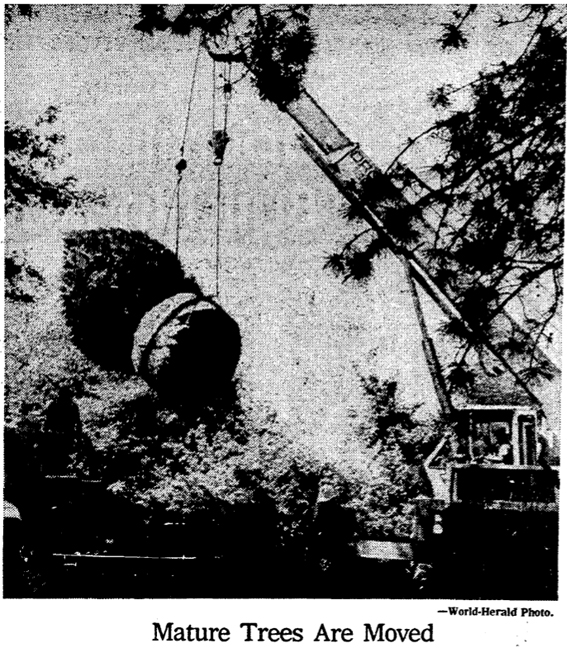
OWH June 2, 1974. “Full grown blue concolor spruce tree looks like a space capsule as it is being loaded onto a flatbed truck near 114th and Pacific Streets. Two of the evergreens were taken to a home site in the Regency subdivision. The earthballs, about 6 feet deep and 10 feet in diameter, weigh approximately 14 tons, said L. D. Torpy, whose workmen moved the trees. The crews also transplanted two 45-foot European Lindens, which weighted about 22 tons to replace Elms near 65th and Underwood Avenue. The digging job took four men about a week on each tree.” The Tomlinson daughters apparently sold off some of the trees, as their father may have wanted, to the other neighborhoods in beautifying efforts.
The Tomlinson Woods Plan
Sleuths, I’m just going to shoot it to you straight, as I assume we all know bits and pieces of what happened next. Developer Glenn Buck bought the Tomlinson property from Margaret and Bunny Tomlinson in 1978. Buck was the head of Creative Land Consultants and was featured previously in my I Want to Live in the Swanson Towers investigation. He set about securing a zoning change to allow for housing in the woods. The Plan: the original proposal had been to build up to 81 high-end single-family homes and a high-rise condominium on the Tomlinson land. Buck wanted to convert the existing carriage house into a restaurant. By the time of the city planning meeting, architect Gary Kathol announced the restaurant and condos had been scratched and only single-family homes would be built—90 in all. For their part, the Creative Land group planned to incorporate the homes into the land, “the trees will be part of the site’s attractiveness.”
Meanwhile Greg Eden became leader of a swiftly moving Arboretum group of neighbors and supporters, who strongly opposed the Buck development. The group hoped to raise donations from private foundations to help buy the land. The Arboretum group focused on the fact that Tomlinson’s wood had the largest cross section of plants in our state. Those opposing the rezoning said the development would destroy the woods that had taken half a century to grow. They asked instead that the area become headquarters for the Nebraska Statewide Arboretum. President of the Nebraska Statewide Arboretum, Wilbur Dasenbrock viewed the Tomlinson planting easily as Nebraska’s “highest class of arboretum,” placing it in the ranks of the Morton Arboretum of Chicago, the Denver and St. Louis Botanical Gardens.
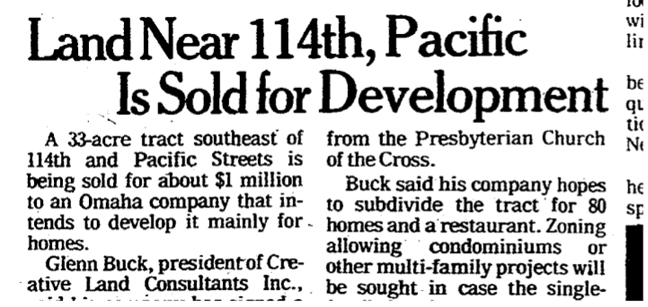
OWH June 1978
Throughout 1978 there were highs and lows in the Tomlinson project, as citywide attention grew. The Omaha City Council would postpone a decision on the proposed Tomlinson Woods housing project so members could visit the site. A state curator showed interest in the proposed Arboretum and politicians would tour the land. The owners, Creative Land Consultants, then said they would sell to the Arboretum backers at a $1.75 million asking price and the Arboretum group must have their money raised within a few months. Of course they knew this was an impossibility. After an attempt to obtain federal money to buy the site failed, the City Council finally agreed to the rezoning. The development would go through, as Creative Land Consultants agreed to make a “special effort” to preserve as many of the trees as possible. The developers estimated that 25 to 50 large trees were removed and said that 1,000 or more trees were transplanted from home sites to other locations in the development.
In the research of the Tomlinson property, I would discover Pat Drickey’s name, when he was mentioned in an article from July of 1978. Pat and Karen Drickey had been caretakers and stewards of the Tomlinson land when the daughters decided to sell. Pat was and continues to be a professional photographer in Omaha. He is nationally known for his body of work (stonehousegolf.com) as well as for directing Gallery 1516 (gallery1516.org). He is possibly the only person alive with explicit knowledge of Tomlinson’s passion and history. Of course, detectives, you know I telephoned Mr. Drickey. As of yet, I have not heard back. So allow me to share his words from the past.
The Pat Drickey File
In August of 1978 Pat and Karen Drickey were given a 30-day notice to move out of the Tomlinson property, after having been told by the Tomlinson sisters they could have 90 days. Pat had been a quiet caretaker to the land for a couple of years, working at Photographers Associated but after all the scuttlebutt with the proposed Creative Land development, he would become vocal. He would also use his photographs to try to educate and advocate for preservation of the land. Drickey would create a slide presentation for showing before civic groups and I have heard there was a book or printing. Can you imagine the photo collection he must have?

OWH 1978.
Drickey based his Tomlinson history on talks with the heirs and other neighbors in the area, since long gone. He described a strong feeling for the doctor who worked and created the wood. “I think this was the doctor’s favorite tree,” Drickey said, pointing to an American Linden. “You can turn a 360-degree circle from here and see virtually every species in the forest.” Drickey’s perspective was that developers should not pit against environmentalists, emphasizing that those who care for nature, “are developers, too. We see the city as a whole. An arboretum is a development, part of the fabric which is woven together to make this a pleasant community to live in.”
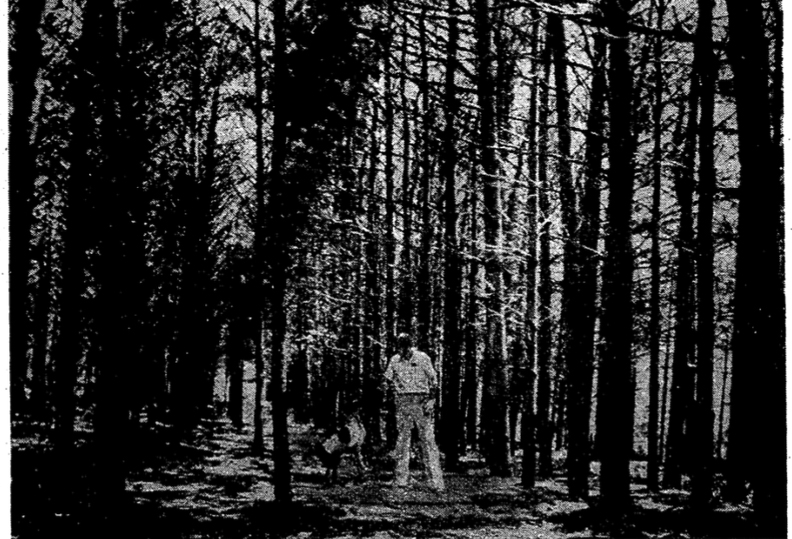
OWH 1978. Patrick Drickey and his dog in the Tomlinson wooded area. An amazing image. Next to the photo of the original brick entryway, this is tops.
The Work Begins: A Clippings Dossier
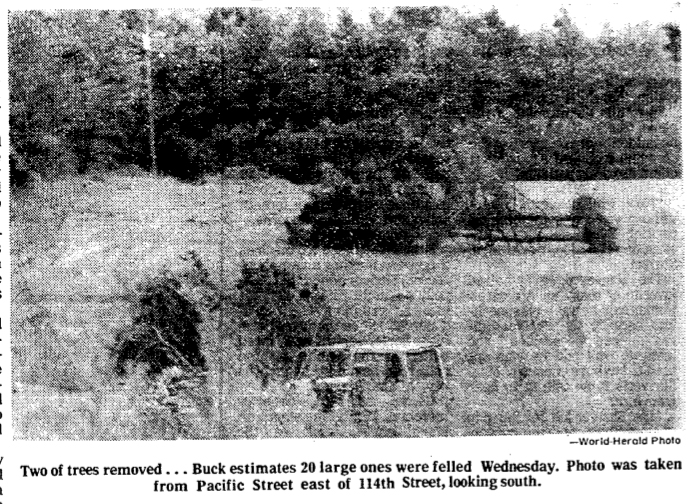
October 1978 photo taken from Pacific Street, east of 114th, looking south.
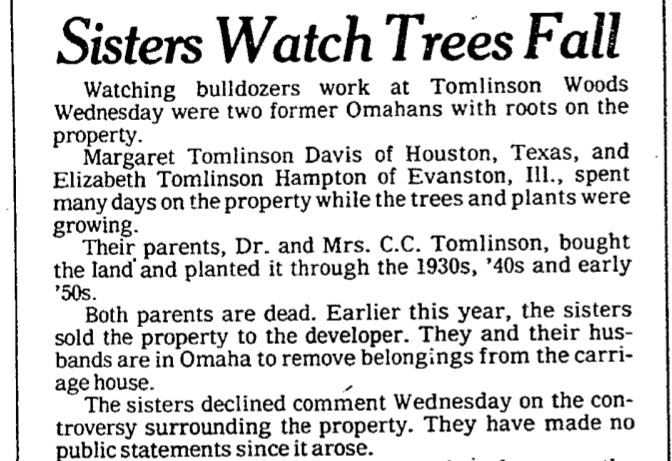
October 1978 Sisters watch trees fall.
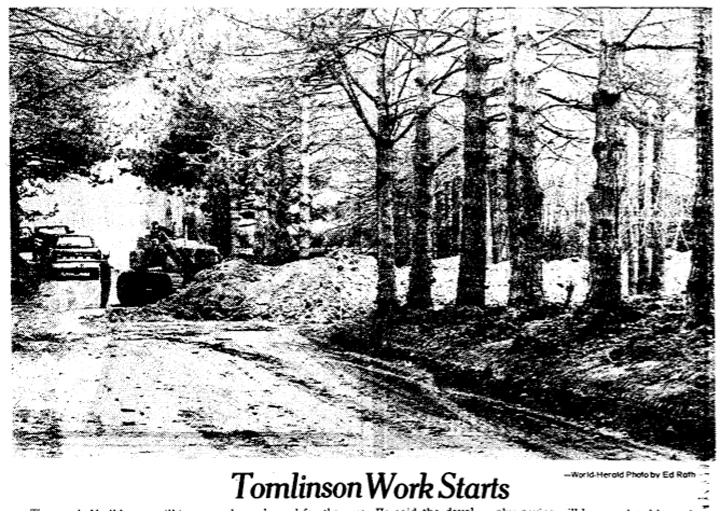
April 1979: camera is pointed west toward 114th street thought to be a block away. Growl of the bulldozers in Tomlinson Woods as Woods Joint Venture, which owned the 35 acre tract prepared for development. Gene Svensen president of the firm.
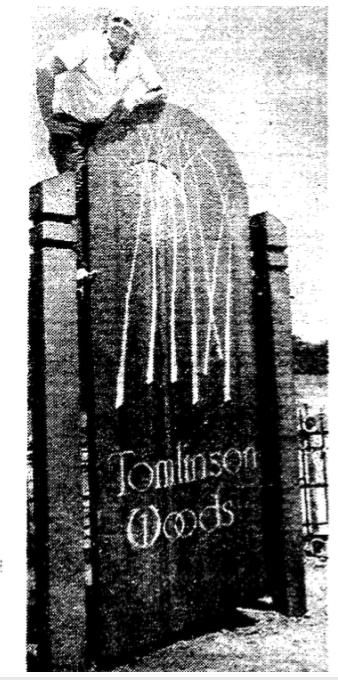
July 1979 original Tomlinson Woods Sign with Buck. Touted to be the most prestigious development of Omaha. Buck declined to name the 22 persons who had bought the 30 lots, some bought more than one. “They are just the most elite attorneys, brokers and business people in Omaha.” My, my… City Planning Director Alden Aust called it “the next Regency, and possibly the next Fairacres.” Sewer, water and gas lines are in and street paving is to begin.” This is how I remember the sign looking when I was young—like the Sunshine Family whittled it out. So Seventies!

OWH June 1981. Nearly half of the 90 lots had sold. A dozen houses were finished and another seven under construction. Gene Svensen, head of Creative Land Consultants, developers of the subdivision, said he expected more houses to be occupied by the end of the year. Lots sold for $45,000 to $65,000. Estimated construction costs of houses were in the $250,000 range and that was back in 1981.
The Fireplace Clue
I would find the Omaha City Directories provided the names of early Tomlinson Woods owners. Ex-Mayor P. J. Morgan’s home was among the first built in the neighborhood. Morgan has remained a strong advocate for the beautiful, wooded neighborhood and I believe, maintains the property through his real estate company and neighborhood association.
Fireplace: Early on, one of the Creative Land group members said that he had hopes that someone would “build around the fireplace.” He noted the Tomlinsons’ summer cabin has been demolished, but that the two-story fireplace remained. He envisioned that “someday a buyer will purchase the lot and construct a house around the huge fireplace.”

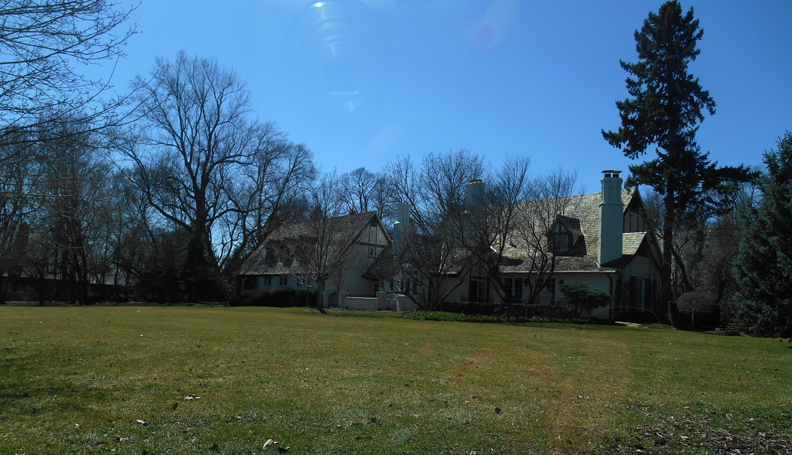
In my pursuit of what happened to that fireplace and chimney, I would continue to zero in on the 11211 Pierce address, as it seemed the most plausible of suspects. The home, having been christened “Tomlinson House” was constructed in 1983, when it was newly listed under the name of a metal processing and trading company heir. This is the home I has showed images of previously. There is evidence that the original Tomlinson carriage house remains and is enveloped in this estate at 11211 Pierce. Does the fireplace relic remain? Hungry Minds Want to Know!
People say the sight of the Tomlinson Woods development is one of the prettiest things a person could see. They are right. I have long marveled at the feel of this neighborhood. However because of its gated environ, it will never be a place of solitude for me and its secret passages are not mine to wander along. Through these months I have been able to see the Tomlinson forty acres of fairyland woods and I bet if you close your eyes, you, too, can see what once was.
For Sister of Mr. Cassette, my sister who loves the trees. With love.
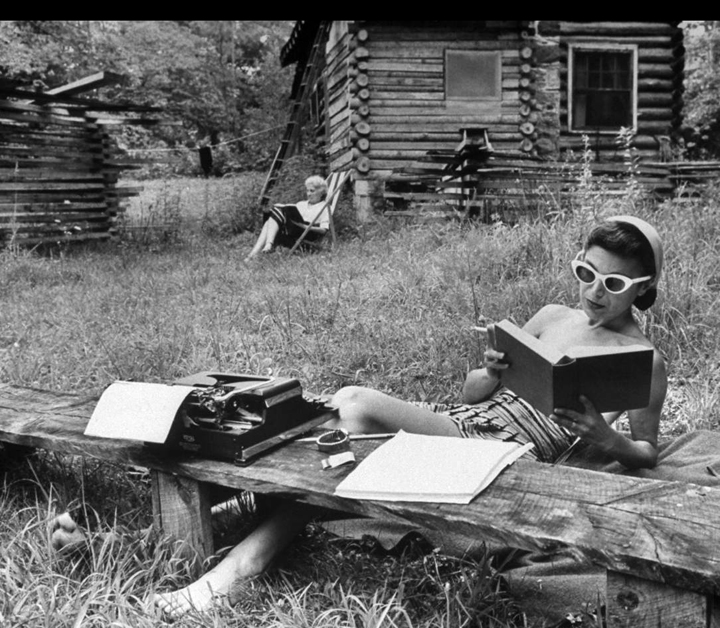
This is only a small part of the story. I would love to hear from you. Please feel free to leave a memory you have of Tomlinson Woods in Comments. Thank you, friends.
You can keep up with my latest investigations by joining my email group. Click on “Contact” then look for “Sign me up for the Newsletter!” Enter your email address. It will then display “Thank you, your sign-up request was successful!” Make sure to check your email address to confirm. You will get sent email updates every time I have written a new article. Also feel free to join My Omaha Obsession on Facebook. Thank you, Omaha friends. Miss Cassette
© Miss Cassette and myomahaobsession, 2019. Unauthorized use and/or duplication of this material without express and written permission from this site’s author and/or owner is strictly prohibited. Excerpts and links may be used, provided that full and clear credit is given to Miss Cassette and myomahaobsession with appropriate and specific direction to the original content.

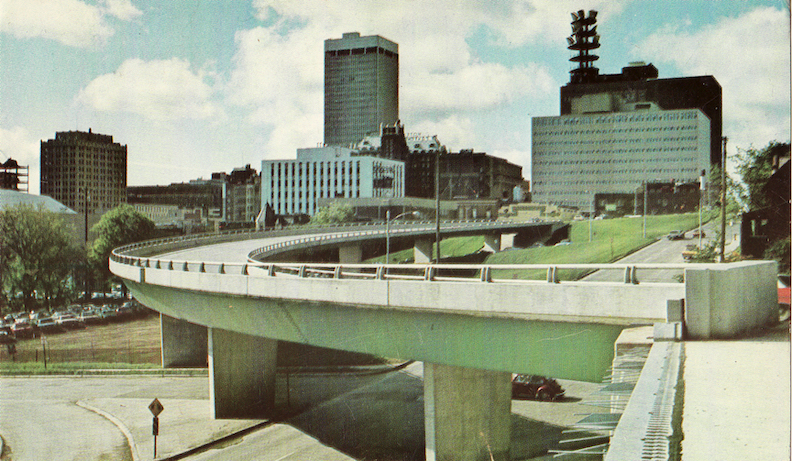

I don’t know a thing about Tomlinson woods, but my guess is they were not nearly as old beautiful as the woods around Hummel Park and Ponca Hills are! When my husband and I were dating in 1973, he would take me in his station wagon after dark and show me a place up on a hill off a windy road that was supposedly an albino farm and then we would go over “screaming woman” bridge. My guess is these were ways to get me to sit closer to him in his car and possibly result in parking somewhere to “smooch” for awhile. But I was too scared to even consider that! Those were the days;-)
Back in the 1968 when there were just 3 channels on what was likely a black and white TV, no smartphones, no streaming music, no internet, and no video games we had to be inventive to keep ourselves entertained. One of the many tools in our toolbox was to take unsuspecting victims, preferably female, to a spooky place where being scared they would jump into the safety of our waiting arms. Of course it was very important that you gave them the proper build-up first. And what a build-up we gave them before going to “The Albino Farm”. Our Albino Farm was east of 72 and State on a spooky dirt road. The Albino Farm, Shipley’s Graveyard in Ponca Hills, and the Black Angel in Council Bluffs were all on our list of places to go!
Fabulous article Thank you so much for investigating and writting zuch a thorogh history of this area. You are amazing. I can’t stop reading once I start. Weren’t you writting a book? Did I miss it?
Thank you so much. I loved researching the Tomlinson Woods story and didn’t want it to end. They say the book is supposed to come out this fall. It has seemed like I turned it in forever ago. Thanks for leaving the light on!
We hung out there a lot as kids. We lived on the East side of the interstate in Rockbrook, so we would take the sewer tunnel under the interstate and build bon fires over there. Also remember going in the big old barn. We always called it the albino farm.
We moved to omaha from England few years ago . The houses in Tomlinson wood reminded us of Cotsworld houses and old english manor houses.The location is perfect to good schools ,downtown,libraries,shopping malls and interstate. The walking trail is so tranquil, serene filled with the chirping of the birds .One encounters many squirrels rabbits occasionally one or two foxes . I have seen turkeys walking up the driveway like soldiers on a parade. Deers are also seen at times.One of my fondest memory is, on a wintry day ,a particularly snowy one ,of seeing two foxes with their beautiful bushy tail doing a courtship dance from my window. One forgets you are so inside a city and not living up on the mountains. The very tall pine trees, the big oak trees ,the maples ,the beautiful gardens … just awesome. I always wondered what the history of this place was. Reading this article has shed so much light on our house and the area. Thank you
Ref. Cumberland and Bedford pig.
Cumberland sausague is a very tasty meat in the UK. I do not know much about the Bedford my guess it is now a rare breed. But the Cumberland is not. The name Tomlinson is a very old North European name. The clue is in “son” meaning son of Tomlin.
Kind regards
Bill Ellis.
My sister Melissa knew what must have been a grand or great-grand-daughter named “Bunny” when she was very little. I would ride with my Mom to those woods to drop Melissa off to play for the afternoon. This must’ve been about 1962-63. I don’t recall ever entering those woods after that. It had to be a peaceful retreat in those pre-interstate years, with fresh air and all the adventure a child could want on a sunny day! The Leo A. Daly family had a ‘country home’ as well on 102nd & Blondo about these same years. I think I can understand these summer homes being a nice get-away from the city without traveling too far.
The fireplace is absolutely still there, even as recently as when I was a highschool senior 4 years ago off of a trail that runs around the perimeter of the property. About 20 meters off the trail towards I 680 you can still the broken down chimney. I live in the neighborhood across 114th street and would take friends back into the woods and tell them stories about how they were haunted and show the chimney as proof of a former ritual site. Really cool to read the real history behind the woods. I’ve roamed the woods around there for a long time and always wondered about the chimney. Just figured it was an unfinished project by one of the people who live across the trail.
Mike–thank you for this! I must see it for myself. Now I am beyond intrigued. Thank you
My parents built their home in 1980 @ 11125 Pierce Plaza, and subsequently bought the neighboring property @ 11105 Pierce Plaza a couple of years thereafter where the chimney sat. We always wondered what the history was, but never knew … now, some 41 years later, I know the answer.
Thank you so much for this wonder record of history in Omaha!
Hello Steven, this is amazing! So the chimney was in the empty lot? Oh my gosh… I’d love to know more if you could elaborate. Thank you so much. Miss Cassette.
Yes, the chimney was still in the lot @ 11105 Pierce Plaza in the early eighties. My parents subsequently sold their home in late 1984 and I’m not certain if the adjoining property was part of that sale. My parents have since passed, and my aunt, the realtor who facilitated the sale, has also passed. Some subsequent aerial photographs suggest it was based on the expansion of the home towards that direction. I haven’t been back to Omaha since 2008 when I last visited the property, and can’t recall if the chimney was still standing then … I’m going to search for possible photographs from that time period and will keep you posted if I learn more.
I was born in 1947. My parents bought one acre on Cryer Ave, about a half mile SW of the Tomlinson property. They built a one bedroom home on that one acre, and it is still there, only recently turned into a garage. So, you see, I grew with that that area. Skylark, and the other housing developments were not there. A creek ran just west of our little house, a magical place for a boy growing up. My mother would pull my sister and me down to Center street, where our mail box was. This would be at about 115th and Center. Across center was a farm, actually farms everywhere. We “ate out” at the Dutch Mill, which was a truck stop, roadside service station restaurant run by Hank and Hazel Stolley. Behind the Dutch Mill were “tourist cabins” mostly rented out long term. The Dutch Mill is under the Center Street and Interstate interchange. It was on the north side of Center. Anyway……we went to a one room school at 126th and Pacific. Next door were the Fultons, Archie (Jr) and Jim. Jim was one year older than me. I see you mention Archie Fulton (the father) in the Tomlinson story. The mother was Ann as I recall. Across Pacific south, was the Highland Country Club which was a Jewish country club. A half mile east on 132 was the Boys Town Farm, run by the Renard family, whose kids were Hugh, Jerry, and Robin. As time went on, the one room District 60 school needed replacing. My Dad tour it down to get the lumber to build our new house, next door to the one bedroom house. This was, of course, AFTER the construction of a two story, brick, four classroom building. That building took me to the 6th grade. Then Omaha Public Schools annexed District 60, and my next stop was Monroe Jr High. Talk about “bussing”. We went there for 7th grade. Dr Brown was our principal. Then Lewis and Clark was built, and the bus ride was a bit shorter. It was only when I went back to Benson High, sophomore year, that the Tomlinson connection shows up. During the development of west Omaha, the Western Electric plant in Millard caused explosive growth. Skylark and Meadow Lane were maturing developments and many busses had to haul kids east to school until Beveridge was built. But during my time at Benson, as a sophomore, driving to school now and hanging with Benson kids who drove, the “albino farm” story came my way (as did the sunken graveyard near Irvington, “hook” in Hummel Park). I challenged the story teller to let me know where this “albino farm” was, since all he said was “west Omaha”. Well, I LIVE in “west Omaha” so where is it? “The corner of 114th and Pacific”………WHAT!!!! You mean the Tomlinson Estate? (That is what we called it). “I dont know about that he said, but we snuck in and looked at the albinos eating supper in their cabins and one of them ran out with a shotgun”…..Well, I had been friends since my early years with the kids of the caretakers, when there were kids. Our District 60 classes, all 8 grades of us, would have our end of school summer picnic there. One the kids, who we called “Big John” was in our one room school and he mother and maybe father lived there. I wish I could recall his last name, and your story teased me with the ad for a nurseryman but did not see what transpired from that. We are talking about 1952-1953. Loved your story and I have another opportunity to debunk the Tomlinson Estate albino farm story. Now…..I do have to say this “Hook Lives, Beware”……
I love everything about this! Thank you for this rich history! We need Big John.
Dear Larry,
Is this your card? 😉
https://www.redfin.com/NE/Omaha/11572-Cryer-Ave-68144/home/103603508
Recently sold in July 2021 and has a beautiful drone shot of your old home. Was that little brick “wall” in the back built by you & your family? What happened to the creek in the area?
I grew up on the northern edge of Benson, drove past Benson High every day to get to school at Brownell-Talbot, now live near Irvington. Would love to hear about any memories/details of Irvington you have – urban legends or facts 🙂
Warmest regards
Hi Larry! Love your great story telling! My Dad (Douglas Joseph Michael “Doug” / “Doug Sr.” Partch Sr.) was born in September of 1940. We just lost him on December 22nd, 2023 at 83 Years old. My Dad’s Mother (Beata Marie “Beatrice” Rome Partch), was accidentally electrocuted to death when my Dad was about 8 months old. My Dad and his older Sister were then basically abandoned by their Father. They were raised by their Maternal Grandparents for bit in St. Peter, Kansas. Ultimately due to their Grandparents already advanced ages and declining health my Dad ended up at Boys Town being raised in Cottage #21. The Boys in Cottage #21 became his brothers. He graduated from Boys Town in the Class of 1959. He left Boys Town with his car and $25.00 in his pocket. He was a Lifetime Member of the Boys Town Alumni Association and he never missed a Boys Town Annual Family Picnic since he graduated. Years later my Mom (who was my Dad’s Childhood Sweetheart and the Love of his Life) worked for Boys Town as well. Since both my Dad and Mom grew up on Farms (and a Cattle Ranch) in St. Peter, Kansas they both had a deep love of the Farm at Boys Town. One year in the mid 1990s they raised Turkeys at their home and released them out at the Farm at Boys Town. For years my Mother, I, and my Daughter BrandiRose tended and cared for the Roses and Rose Gardens out at Boys Town.
(Unfortunately for you) THERE’S MORE….on one of your plats in your presentation, you will see the name “J.H. Cryer Est.”. This was Colonel Cryer, according to my Dad who passed away at 93 last year (2020). Cryer’s plat turned into Happy Hollow View in a later plat. That was where my folks 1 acre was. So, my young kid imagination always wondered who Colonel Cryer was. My folks acre is on Cryer Avenue, btw. It used to run from Center, up to the northwest at an angle, then turned west to intercept 120th. When Ted Reeder built the office building at 114th and Center, he got permission to put a cul-de-sac there and that ended the connection of Cryer Ave to Center. I rode my horse thru the first asphalt being laid for 114th. It was gravel up to that time. It was the horse’s fault. So another mystery….WHO was Colonel Cryer?
Not sure about a brick wall. There was a brick outdoor cooking set up. Still there. Yes, Gary Adams did a great job on the house. It was sad to say goodby when it was time to leave Omaha and head back to Lower Missouri where I live. We used to go to Irvington for the Homestyles, which were brutally good chocolate treats. Not sure how old you are, I am guessing younger than me and I am 75. But I had a childhood friend, Richard Strough, who went to Talbot. I only went to Benson as a sophomore in 1963, until they finished Beveridge, which because Burke. My education followed the growth of Omaha west.
I remember Cryer Avenue very well. Great short cut to hit Belair Plaza where the Hobby Store and Food City were at. Us kids would head West off of Gold Street to 114th, jog a bit up North just past the tall trees that lined 114th Street (my secret reading place) and head over to the Cryer Pool and Tennis Court. Both my older brother “Doug Jr.” and I were on the Competitive Diving Team for Cryer. We also dove at Westwood too. Had many Friends from Burke because of that. Two of my Boyfriends lived just North of the Cryer Pool. And you are right Omaha just kept expanding West. I remember when 132nd was nothing but fields.
My Folks, Douglas Joseph Michael Partch Sr. and GlorieJune Mary Marie Spies Partch built one of the very first homes just up from 114th and Center Streets (North East of that Intersection) at 113th and Gold Street in the early 1960s. Our house sat at the very top of that hill facing South. My Dad had grown up at Boystown and graduated from there in 1959. My Dad owned the Rockbrook Village Barbershop, the longest standing single owned business in Rockbrook Village. As kids in the 1960s – 1970s my two Brothers and I during the Summers would round up our neighborhood friends and ride our bikes up to and into Tomlinson Woods. We would spend the afternoon fishing the ponds there and catching Tadpoles, and Frogs, and Toads, and would try and spy where the Turtles were hiding out. We then would have Frog / Toad jumping contests to see whose Toad or Frog would jump out of the circle first. The Wildlife in Tomlinson Woods made it a very magical place for a bunch of Nature loving kids. Butterflies and Dragonflies were everywhere, just as were the Rabbits and Squirrels, and Birds, and an occasional Deer or two. Tomlinson Woods was a place of beauty, peace, and tranquility. As kids we had absolutely no clue that we were trespassing on someone else’s property, and nobody ever seemed to mind us being there either. I was in Gym Class at Valley View Jr. High School in the mid – later 1970s when we saw plumes of black smoke billowing from Tomlinson Woods. If I remember the rumor correctly a bunch of homeless guys that were squatting on the property and in the abandoned house or carriage house accidentally set it on fire trying to keep warm. I remember thinking how sad it was that all the beautiful antiques store there were going to be destroyed. It was a very sad thing when they started digging up and tearing out the beautiful trees that Dr. Tomlinson and his Family had lovingly planted there over the years. Yes, I was definitely on the side of keeping it as an Arboretum, a Botanical Garden, a Nature Center, and Wildlife Preserve.
Thank you, Julie, for this vivid imagery. I could see and hear it! What lovely memories. Thank you for the added clues about the fire!
Julie, there is absolutely no doubt that your Dad cut my hair from time to time. When they built that building, all of the neighbor kids were thrilled that maybe we could get some after school jobs. Jerry’s Market was next door to your Dad’s shop, or pretty close to next door. I recall one of the barbers was a younger guy with a cool “duck tail”. Your Dad ‘s shop was on the bottom floor, facing north (Center). The backside of the building was the second floor, facing south. On the west end was a drugstore. We immediately named that our “hangout”. I never got a job at Jerry’s, but my friend Dave Oman did get one.
Hi Larry! Interesting bit of History that you provided there. The 1st Rockbrooke Village Barber Shop was on the top level of the strip, but Yes, it did face North towards Center Street. That 1st Barber Shop experienced a fire, very early 1960s. The 2nd Rockbrooke Village Barber Shop that my Dad owned for 55 Years opened on the lower level of the strip, and it too faced North over looking Center Street. (There was / is even a World Herald Story written about my Dad and his Barber Shop.). Not sure about a “Jerry’s Market”, but clearly remember that Dr. Harless’s Vet Clinic was right next door to the West of my Dad’s Shop. Whenever a Critter got orphaned or abandoned, or people didn’t come back for their Pet or pay their Vet Bills, Dr. Harless would walk that Critter right next door to my Dad, and my Dad could never say “No”. We ended up with a whole zoo of Animals at our home as a result of that. Dr. Harless gave us a Silver Tabby Kitten that we named “Stripes” after our Gray Tom Cat “Tom Tom” died unexpectedly on my little brother’s bed one night. I had that Kitty “Stripes” my entire Childhood. When I got married at 18, in 1981, my Folks wouldn’t let me take “Stripes” with me, because our home on Gold Street was the only home he had ever known. I clearly remember the Drug Store being to the East of my Dad’s shop, right next door to my Dad’s Bank which was on the end of that lower part of the strip. My Dad use to send us kids over to the Drug Store to buy him Hershey’s Chocolate and Almond Candy Bars, which initially were only 5 Cents back then. I still remember when they went up to 10 Cents, then 15 Cents, then 25 Cents, and then up to 50 Cents. I remember too when they opened a Baskin Robbins Ice Cream Store right next door to the East of my Dad’s Barber Shop. My Dad wasn’t very good about taking any kind of break or lunch break when he was behind his barbering chair all those many years, but he often would send us kids over to get him a Malt or Shake from there or from the Robert’s Dairy Store. My Dad often treated us kids to Ice Cream too, and when his Grandbabies came along he did the same. When my Mom was visiting there at the Barber Shop us kids hit our favorite places in Rockbrook Village; the Pet Store, which our Neighbors owned, (we spent a lot of time there), the Craft / Bead Store, and the Music Store, where both my little brother and myself took Guitar Lessons. Godfather’s Pizza was one of our favorite hang outs during our High School Years. We would cruise on Friday and Saturday Nights from The Godfather’s Pizza, to the Burger King on 90th, past Westside, and onto the McDonald’s on Dodge Street. And everybody in my family loved “The Garden Cafe” in Rockbrooke Village. “The Garden Cafe” was my Daughter BrandiRose’s favorite place to go for Mom / Daughter Dates Out. She always ordered their Fresh Raspberry Pie for dessert. My Daughter’s Modeling School was also in Rockbrooke Village too. I had a laugh about your “Duck Tail” Haircut. Even though I absolutely hated it my Dad cut my hair when I was a little girl, just like my two brothers. He always gave me a “Pixie” Cut back then. He did though once give me a “Wedge” Haircut, which is very much like a “Duck Tail” Haircut, when I was in Jr. High. Funny how some places, just like Tomlinson Woods, can hold so many memories. Peony Park is / was another place that holds a lot of memories too. Was really sad when they tore it down as well. Blessed though that I got to take both my Daughter and my Son there before it went.
I lived in the Prairie Lane area. On 114th just past Center Street. If I could get away from my parents long enough on my bike, I would go wandering thru Tomlinson on “nature excursions” Collect pond water for my new microscope. Probably around 68, 69. The albino thing was a kid scarer told by older kids. I knew Doug Partch and their dad. Fun and Scary. And if my parents found out I went that far (and they did) I was in T R O U B L E.
David B. Anderson, All us kids went to Prairie Lane Elementary School (Doug Jr., myself, and our little brother Jay J.), followed by Valley View Jr. High School, and then Westside High. We are still Friends with a lot of the Kids and Folks and Families that grew up with us on Gold Street. Sadly we just lost our Dad, Douglas Joseph Michael “Doug” / “Doug Sr.” Partch Sr. on December 22nd, 2023. He will be missed by many. He loved the “Woods” as well. My Dad use to build custom Harleys and other Motorcycles too in the 1960s and 1970s as a Hobby. Before he would turn the New Motorcycle over to it’s New Owner my Dad would take each one of us kids on a Motorcycle ride up near the “Woods” and the “Pond”. Great Memories!